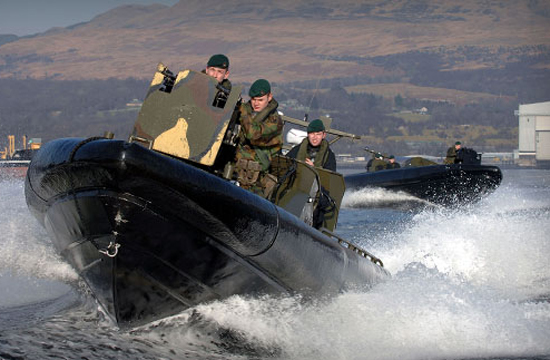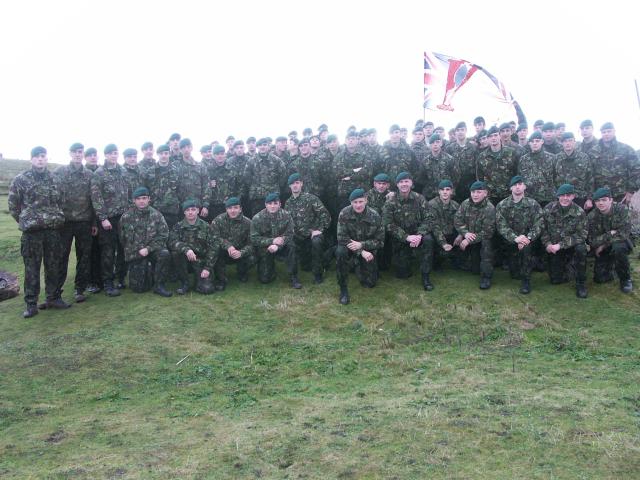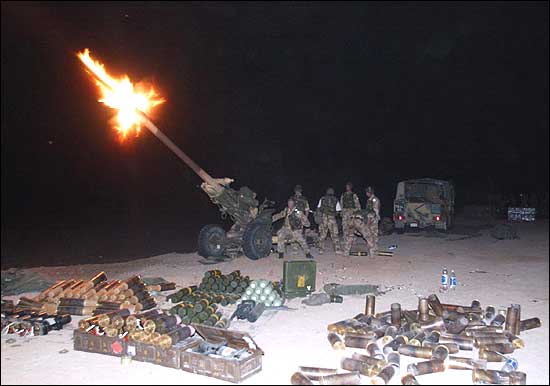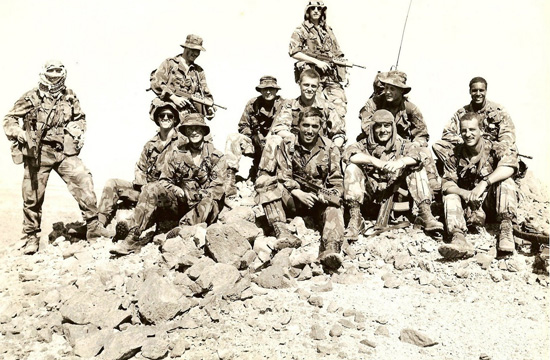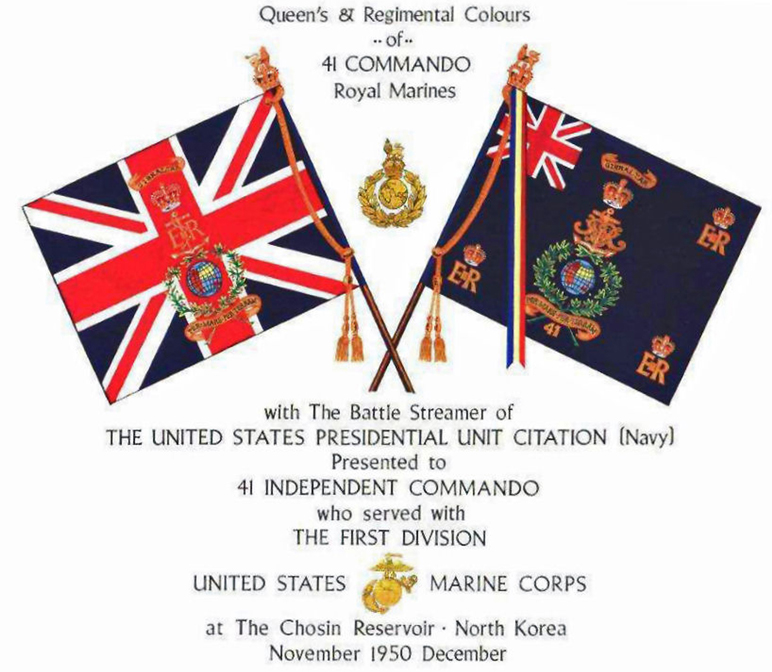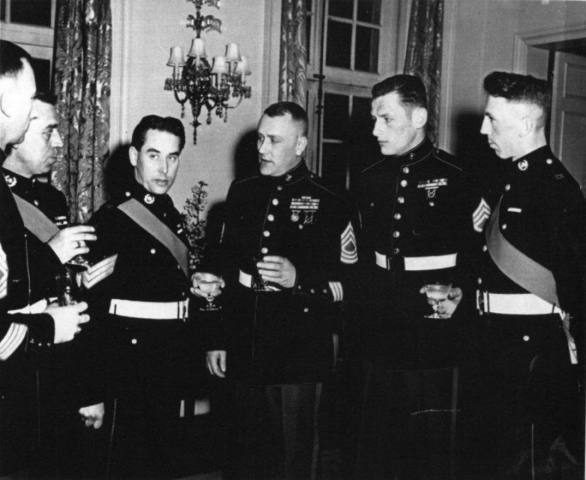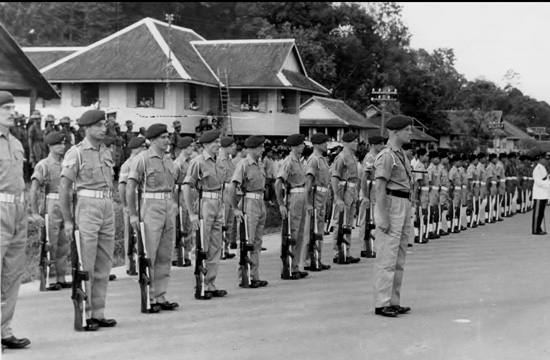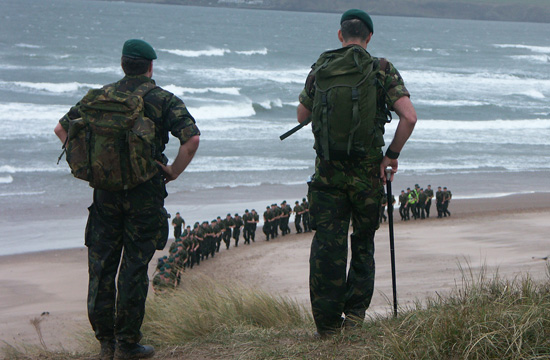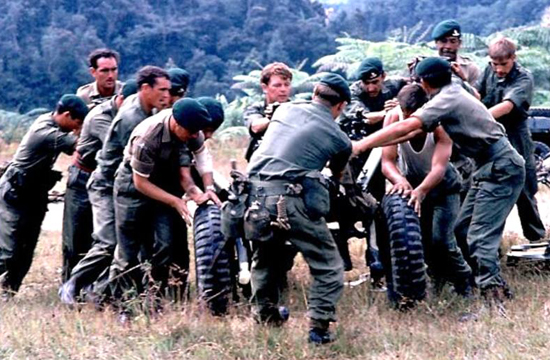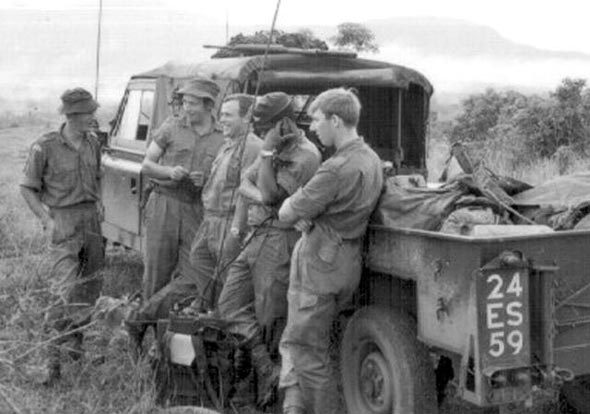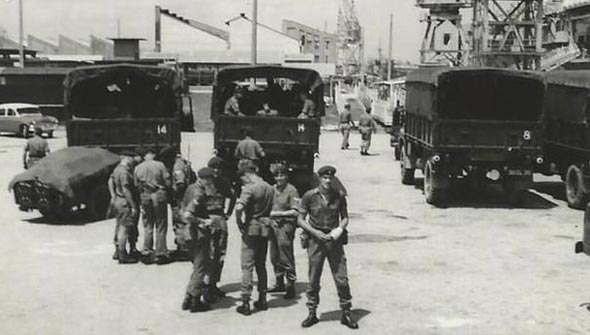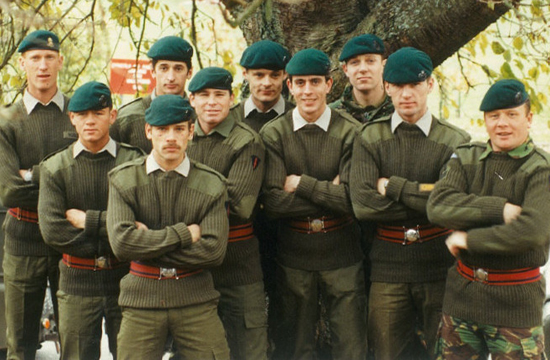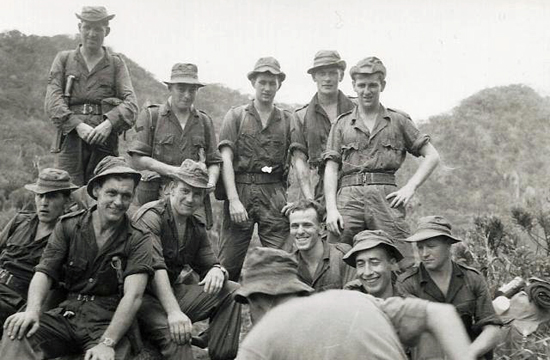'3 Commando Brigade, Royal Marines'
- October 1946 after the disbandment of the merged No.1/5 (Army) Commando, 3 Commando Brigade, still in the Far East, was redesignated as 3 Commando Brigade, Royal Marines.
- 16 March 1947 the then 44 Commando of 3 Commando Brigade RM was redesignated as 40 Commando, Royal Marines. The intention being to perpetuate a Commando representative of the Dieppe raid and the Italian theatre of war, and to recognise their contribution to the Allied victory in Europe as with that of 45 Commando, combined with 42 Commando's contribution to Allied victory in the Far East.
- 3 Commando Brigade RM now consisted of 40, 42, and 45 Commandos, and a Commando Engineer troop.
- April 1952 3 Commando Brigade RM commenced its move to Malta utilising the existing accommodation at the barracks titled St Andrew’s, St George’s, and St Patrick’s.
Additionally Army Commando units have again returned. During 1962, 29 Field Regiment RA were deployed with 25 Pounder guns in Aden and Kuwait, deterring Iraq from invading the oil fields. On the back of these deployments, the Regiment was re-roled as Commando Artillery. The newly formed 29 Commando Regiment RA trained for and passed the All Arms Commando Course at the Training Centre Royal Marines, Lympstone. It was a proud and historic moment when the first Army Commandos since the end of the War received their Green Berets on 15 May 1962.
24 Commando Royal Engineers provides integral engineer support to 3 Commando Brigade Royal Marines. Currently 24 Commando consists of 54 Commando Headquarters and Support Squadron, 56, 59, and 131 Commando Squadrons, and REME workshop.
Today's Commando Logistic Support Squadron can trace its commando roots back to the 8th May 1964 when four Officers and 24 RAOC storemen and clerks completed their commando training and were awarded their Green Berets as part of the new 3 Commando Brigade Ordnance Field Park. Changing its name in 1972 to the Commando Ordnance Squadron, then being renamed again as the Commando Logistic Squadron in 1996.
To earn the right to wear the coveted green beret you must first pass the All Arms Commando Course.
Read more about the origins of the Commandos in WW2 [go to commando history.]
'Roll of Honour since 1946'
Roll of Honour Army and Royal Marines Commandos
The links below take you to the names in decade order of those who have 'Died in Service' since 1946. You can also search the full Commando Roll of Honour by surname or date.Died in service 1946 - 1979
Those who died during their commando course.
Click on surname for full details.
This Roll of Honour is not complete as its is in the process of being compiled.
Contact us if you have information on any individual.
|
1946 - 1949
|
|---|
|
Surname
|
First name
|
Rank
|
Unit
|
Year
|
|
Samuel
|
Cpl
|
41RM Commando
|
1947
|
|
|
Robert
|
Sgt
|
RM Commando
|
1946
|
|
|
Hubert
|
RQMS
|
40 Commando RM
|
1949
|
|
|
George
|
WO2
|
No 3 Commando
|
1946
|
|
|
James
|
Cpl
|
40 Commando RM
|
1948
|
|
|
Thomas
|
Pte
|
No.1 Commando
|
1948
|
|
|
John
|
Capt
|
Commando School RM
|
1948
|
|
|
William
|
Mne
|
45 Commando RM
|
1957
|
|
|
Horace
|
CSM
|
42 Commando RM
|
1948
|
|
|
Michael
|
Mne
|
45RM Commando
|
1946
|
|
|
Arnold
|
Lieut
|
40 Commando RM
|
1949
|
|
|
Ronald
|
Cpl
|
No 5 Commando
|
1946
|
|
|
William
|
Pte
|
No 3 Commando
|
1946
|
|
|
George
|
Mne
|
3 Commando Bde. RM
|
1947
|
|
|
Charles, A.M.H.H.
|
Mne
|
HQ, 3 Commando Bde RM
|
1948
|
|
|
Roger
|
Mne
|
42 Commando RM
|
1947
|
|
|
Kenneth
|
Mne
|
45RM Commando
|
1946
|
|
|
T.H.
|
Pte
|
No 5 Commando
|
1946
|
|
|
Percy
|
RQMS
|
45 Commando RM
|
1949
|
|
|
Norman
|
Mne
|
45 Commando RM
|
1949
|
|
|
Rexley
|
Mne
|
3 Commando Bde. RM
|
1947
|
|
|
Luther
|
Mne
|
42 Commando RM
|
1949
|
|
|
John
|
Lieut
|
3 Commando Bde. RM
|
1946
|
|
|
Frederick
|
Pte
|
No 4 Commando
|
1946
|
|
|
William
|
Pte
|
No 5 Commando
|
1946
|
|
|
William
|
Sgt
|
42RM Commando
|
1947
|
|
|
Joseph
|
Mne
|
45RM Commando
|
1946
|
|
|
Thomas
|
Mne
|
45RM Commando
|
1946
|
|
|
Alfred
|
Mne
|
3 Commando Bde. RM
|
1949
|
|
|
William
|
Cpl
|
45RM Commando
|
1947
|
|
|
Peter
|
LCpl
|
No 2 Commando
|
1947
|
|
|
Charles
|
Sgt
|
Commando School RM
|
1948
|
|
|
Thomas
|
Gnr
|
No 4 Commando
|
1947
|
|
|
Thomas
|
Mne
|
42RM Commando
|
1947
|
|
|
Ernest
|
Cpl
|
42 Commando RM
|
1947
|
|
|
Ronald
|
Mne
|
40 Commando RM
|
1948
|
|
|
Maurice
|
Mne
|
42RM Commando
|
1947
|
|
|
Ernest
|
Mne
|
44RM Commando
|
1946
|
|
|
Sidney
|
Mne
|
45RM Commando
|
1946
|
|
|
Arthur
|
Mne
|
40RM Commando
|
1947
|
|
1950 - 1959
|
|---|
|
Surname
|
First name
|
Rank
|
Unit
|
Year
|
|
Gerard
|
Mne
|
41 Independent Cdo. RM
|
1951
|
|
|
Arthur
|
Mne
|
41 Independent Cdo. RM
|
1951
|
|
|
Charles
|
Mne
|
40 Commando RM
|
1952
|
|
|
Trevor
|
Sgt
|
Special Boat Service
|
1951
|
|
|
Thomas
|
Mne
|
HQ 3 Commando Bde. RM
|
1956
|
|
|
Ronald
|
Cpl
|
41 Independent Cdo. RM
|
1950
|
|
|
David
|
Sgt
|
45 Commando RM
|
1958
|
|
|
Charles
|
Sgt
|
41 Independent Cdo. RM
|
1951
|
|
|
Terence
|
Mne
|
45 Commando RM
|
1950
|
|
|
Donald
|
Cpl
|
40 Commando RM
|
1953
|
|
|
Jarvis
|
Cpl
|
41 Independent Cdo. RM
|
1950
|
|
|
James
|
Cpl
|
R.M.F.V.R.
|
1956
|
|
|
Benet
|
Mne
|
45 Commando RM
|
1956
|
|
|
Harry
|
Mne
|
45 Commando RM
|
1958
|
|
|
Paul
|
Lieut
|
45 Commando RM
|
1951
|
|
|
Derek
|
Mne
|
40 Commando RM
|
1953
|
|
|
Graham
|
QMS
|
45 Commando RM
|
1957
|
|
|
James
|
Mne
|
40 Commando RM
|
1951
|
|
|
Roland
|
Mne
|
40 Commando RM
|
1951
|
|
|
Graham
|
Musn
|
HQ, 3 Commando Bde. RM
|
1959
|
|
|
Robert
|
Mne
|
40 Commando RM
|
1951
|
|
|
Richard
|
Mne
|
Commando School RM
|
1952
|
|
|
James
|
Lieut
|
40 Commando RM
|
1951
|
|
|
Ronald
|
Cpl
|
41 Independent Cdo. RM
|
1950
|
|
|
Donald
|
Sgt
|
45 Commando RM
|
1953
|
|
|
George
|
Mne
|
40 Commando RM
|
1951
|
|
|
Donald
|
Sgt
|
42 Commando RM
|
1956
|
|
|
Louis
|
Lieut
|
40 Commando RM
|
1956
|
|
|
Ronald
|
LCpl
|
40 Commando RM
|
1953
|
|
|
Michael
|
Lieut
|
40 Commando RM
|
1951
|
|
|
Lorin
|
Mne
|
40 Commando RM
|
1956
|
|
|
Rex
|
Mne
|
40 Commando RM
|
1951
|
|
|
Brian
|
Mne
|
42 Commando RM
|
1950
|
|
|
Robert
|
Mne
|
Commando School RM
|
1953
|
|
|
Murdoch
|
Mne
|
45 Commando RM
|
1954
|
|
|
Peter
|
Mne
|
45 Commando RM
|
1951
|
|
|
Michael
|
Mne
|
45 Commando RM
|
1956
|
|
|
Ronald
|
Mne
|
40 Commando RM
|
1956
|
|
|
Walter
|
Mne
|
Commando School RM
|
1953
|
|
|
Ivan
|
Mne
|
41 Independent Cdo. RM
|
1950
|
|
| GEACH | Ernest | Mne | RMB Eastney | 1958 |
|
Thomas, J.H.
|
Sgt
|
45 Commando RM
|
1951
|
|
|
George, John
|
Mne
|
R.M.F.V.R. & 4SBS
|
1951
|
|
|
Cyril
|
Mne
|
45 Commando RM
|
1956
|
|
|
John
|
Mne
|
41 Independent Cdo. RM
|
1950
|
|
|
Norman
|
CSgt
|
45 Commando RM
|
1954
|
|
|
Raymond
|
Mne
|
40 Commando RM
|
1958
|
|
| GRIBBLE | Norman, A. | Mne | RMB Plymouth | 1953 |
|
Jack
|
CSgt
|
45 Commando RM
|
1958
|
|
|
John
|
Lieut
|
41 Independent Cdo. RM
|
1951
|
|
|
Peter
|
Lieut
|
40 Commando RM
|
1957
|
|
|
Lewis
|
Mne
|
41 Independent Cdo. RM
|
1951
|
|
|
John
|
Cpl
|
45 Commando RM
|
1951
|
|
|
Samuel
|
Sgt
|
Commando School RM
|
1952
|
|
|
Christopher
|
Cpl
|
41 Independent Cdo. RM
|
1951
|
|
|
Stanley
|
Mne
|
41 Independent Cdo. RM
|
1951
|
|
|
Keith
|
Mne
|
41 Independent Cdo. RM
|
1950
|
|
|
Alfred
|
Mne
|
Special Boat Service
|
1951
|
|
|
David
|
Mne
|
42 Commando RM
|
1956
|
|
|
Norman
|
Cpl
|
40 Commando RM
|
1951
|
|
|
Leonard
|
Mne
|
40 Commando RM
|
1952
|
|
|
Dennis
|
Mne
|
Special Boat Service
|
1951
|
|
|
William
|
Mne
|
41 Independent Cdo. RM
|
1950
|
|
|
Frank
|
Mne
|
45 Commando RM
|
1954
|
|
|
Alfred
|
Mne
|
45 Commando
|
1954
|
|
|
Peter
|
Mne
|
41 Independent Cdo. RM
|
1950
|
|
|
David
|
Mne
|
45 Commando RM
|
1950
|
|
|
Douglas
|
Surg.Lt
|
41 Independent Cdo. RM
|
1950
|
|
|
Ernest
|
Mne
|
40 Commando RM
|
1951
|
|
|
Kenneth
|
Mne
|
45 Commando RM
|
1956
|
|
|
Alexander
|
Mne
|
45 Commando RM
|
1958
|
|
|
Peter
|
Capt
|
42 Commando RM
|
1951
|
|
|
William
|
Mne
|
HQ 3 Commando Bde RM
|
1953
|
|
|
Kenneth
|
Mne
|
40 Commando RM
|
1950
|
|
|
Peter
|
Lieut
|
40 Commando RM
|
1956
|
|
|
Joseph
|
Mne
|
41 Independent Cdo. RM
|
1950
|
|
|
Harry
|
Mne
|
41 independent Cdo. RM
|
1951
|
|
|
Leslie
|
Mne
|
45 Commando RM
|
1951
|
|
| MORAN | Roy | Mne | Commando School RM | 1953 |
|
Henry
|
Cpl
|
42 Commando RM
|
1954
|
|
|
Robert
|
Mne
|
41 Independent Cdo. RM
|
1951
|
|
|
Ernest
|
Mne
|
45 Commando RM
|
1950
|
|
|
Reuben
|
Mne
|
41 Independent Cdo. RM
|
1951
|
|
|
Patrick
|
Sgt
|
45 Commando RM
|
1952
|
|
|
Samuel
|
Sgt
|
40 Commando RM
|
1950
|
|
|
Ralph
|
Capt
|
41 Independent Cdo. RM
|
1950
|
|
|
Dennis
|
Mne
|
45 Commando RM
|
1950
|
|
|
Bernard
|
Mne
|
42 Commando RM
|
1956
|
|
|
Thomas
|
Mne
|
HQ 3 Commando Bde. RM
|
1957
|
|
|
Denis
|
L/SBA
|
RN, attd 41 Ind. Cdo. RM
|
1950
|
|
|
Stewart
|
Mne
|
42 Commando RM
|
1955
|
|
|
Stephen
|
Mne
|
45 Commando RM
|
1969
|
|
|
Terence
|
Mne
|
45 Commando RM
|
1955
|
|
|
Harry
|
Mne
|
42 Commando RM
|
1950
|
|
|
William
|
Mne
|
42 Commando RM
|
1950
|
|
|
Raymond
|
Cpl
|
40 Commando RM
|
1951
|
|
|
Edward
|
Mne
|
Special Boat Service
|
1951
|
|
|
Brian
|
Mne
|
42 Commando RM
|
1956
|
|
|
Stanley
|
Mne
|
41 Independent Cdo. RM
|
1951
|
|
|
Derek
|
Mne
|
45 Commando RM
|
1952
|
|
|
Ronald
|
Mne
|
41 Independent Cdo. RM
|
1950
|
|
|
David
|
Lieut
|
45 Commando RM
|
1958
|
|
|
Gordon Herbert
|
Lt Col
|
RMB Eastney
|
1951
|
|
|
John
|
Mne
|
42 Commando RM
|
1950
|
|
|
Eric
|
Mne
|
41 Independent Cdo. RM
|
1950
|
|
|
Dennis
|
Mne
|
41 Independent Cdo. RM
|
1950
|
|
|
John Arnison
|
PO
|
41 Independent Cdo. RM
|
1950
|
|
|
Maurice
|
Sgt
|
40 Commando RM
|
1951
|
|
|
Charles
|
Cpl
|
41 Independent Cdo. RM
|
1950
|
|
|
Leslie
|
Mne
|
45 Commando RM
|
1950
|
|
|
Edward
|
Lieut
|
40 Commando RM
|
1956
|
|
|
William
|
Mne
|
41 Independent Cdo. RM
|
1950
|
|
|
John
|
LCpl
|
No.6 Commando
|
1951
|
|
|
George
|
Sgt
|
45 Commando RM
|
1951
|
|
|
Brian
|
Cpl
|
42 Commando RM
|
1959
|
|
|
Alfred
|
QMS
|
45 Commando RM
|
1956
|
|
|
David
|
Mne
|
45 Commando RM
|
1958
|
|
|
Royston
|
Mne
|
41 Independent Cdo. RM
|
1950
|
|
|
Robert
|
Mne
|
42 Commando RM
|
1950
|
|
|
Kenneth
|
Mne
|
41 Independent Cdo. RM
|
1951
|
|
|
Terence
|
Cpl
|
HQ, 3 Commando Bde. RM
|
1959
|
|
1960 - 1969
|
|---|
|
Surname
|
First name
|
Rank
|
Unit
|
Year
|
|
Bernard
|
Mne
|
45 Commando RM
|
1961
|
|
|
David
|
Sgt
|
45Commando RM
|
1964
|
|
|
Paul
|
Bugler
|
45 Commando RM
|
1961
|
|
|
Richard
|
Lieut. Col.
|
Royal Marines
|
1968
|
|
|
Keith
|
Mne
|
40 Commando RM
|
1969
|
|
|
David
|
Mne
|
45 Commando RM
|
1967
|
|
|
Reginald
|
Cpl
|
42 Commando RM
|
1964
|
|
|
Ian
|
Lieut
|
42 Commando RM
|
1966
|
|
|
Brian
|
LBdr
|
95 Commando RA
|
1965
|
|
|
Michael
|
Cpl
|
45 Commando RM
|
1968
|
|
|
Vivian
|
Cpl
|
HQ, 3 Commando Bde. RM
|
1968
|
|
|
Bernard
|
Bdr
|
95 Commando RA
|
1965
|
|
|
Thomas
|
Mne
|
42 Commando RM
|
1966
|
|
|
Robert
|
Cpl
|
HQ, 3 Commando Bde. RM
|
1965
|
|
|
James Thomas
|
Bdr
|
29 Commando Regt RA
|
1966
|
|
|
Peter
|
Cpl
|
40 Commando RM
|
1965
|
|
|
Peter
|
Sgt
|
42 Commando RM
|
1965
|
|
|
Ian
|
Lt. Col
|
Royal Marines
|
1960
|
|
|
Mark
|
Mne
|
40 Commando RM
|
1964
|
|
|
Christopher
|
Mne
|
42 Commando RM
|
1967
|
|
|
Mark
|
Cpl
|
40 Commando RM
|
1963
|
|
|
Anthony
|
Mne
|
45 Commando RM
|
1967
|
|
|
Anthony
|
Capt
|
ITCRM
|
1960
|
|
|
Victor
|
Sgt
|
95 Commando RA
|
1965
|
|
|
Hamish
|
Capt
|
Sultan of Oman Armed Forces
|
1966
|
|
|
David
|
Mne
|
45 Commando RM
|
1967
|
|
|
Ronald
|
Mne
|
42 Commando RM
|
1962
|
|
|
Cecil
|
Sgt
|
42 Commando RM
|
1966
|
|
|
John
|
Cpl
|
HQ, 3 Commando Bde. RM
|
1967
|
|
|
Graham
|
Mne
|
42 Commando RM
|
1962
|
|
|
Thomas
|
Colonel
|
HMS President
|
1960
|
|
|
Hugh
|
Mne
|
ITCRM
|
1960
|
|
|
Thomas
|
Mne
|
45 Commando RM
|
1968
|
|
|
Rowan
|
Cpl
|
42 Commando RM
|
1966
|
|
|
James
|
Sgt
|
79 Commando Bty. RA
|
1963
|
|
|
Derek
|
Mne
|
40 Commando RM
|
1961
|
|
|
Joseph
|
Cpl
|
42 Commando RM
|
1964
|
|
|
Gordon
|
Mne
|
41 Commando RM
|
1965
|
|
|
Richard
|
Mne
|
45 Commando RM
|
1964
|
|
|
Geoffrey
|
Gnr
|
95 Commando Regt. RA
|
1965
|
|
|
Reginald
|
LCpl
|
45 Commando RM
|
1963
|
|
|
Richard
|
Mne
|
42 Commando RM
|
1962
|
|
|
Kenneth
|
Cpl
|
42 Commando RM
|
1962
|
|
|
Malcolm, C.
|
Sgt
|
CTCRM
|
1966
|
|
|
Eric
|
Mne
|
41 Commando RM
|
1961
|
|
|
Gerald
|
Mne
|
42 Commando RM
|
1962
|
|
|
James
|
Mne
|
HQ 3 Commando Bde. RM
|
1966
|
|
|
Brian
|
Cpl
|
Royal Marines
|
1960
|
|
|
Walter
|
Sgt
|
42 Commando RM
|
1962
|
|
|
Thomas
|
LCpl
|
40 Commando RM
|
1967
|
|
|
Ronald
|
Sgt
|
29 Commando RA
|
1965
|
|
|
Michael
|
Cpl
|
40 Commando RM
|
1964
|
|
|
Edward
|
Mne
|
42 Commando RM
|
1964
|
|
|
Edward
|
Cpl
|
45 Commando RM
|
1964
|
|
|
John
|
Lieut
|
41 Commando RM
|
1964
|
|
|
Robert
|
Cpl
|
Royal Marines
|
1969
|
|
|
Daniel
|
Lieut
|
45 Commando RM
|
1967
|
|
|
David
|
Mne
|
45 Commando RM
|
1965
|
|
|
Roger
|
Lieut
|
43 Commando RM
|
1962
|
|
|
Percival
|
Mne
|
45 Commando RM
|
1968
|
|
|
Michael
|
LBdr
|
95 Commando RA
|
1965
|
|
|
Thomas
|
Cpl
|
41 Commando RM
|
1961
|
|
|
Peter, J.
|
Mne
|
HQ, 3 Commando Bde. RM
|
1969
|
|
|
John
|
Mne
|
ITCRM
|
1968
|
|
|
Michael
|
Mne
|
45 Commando RM
|
1968
|
|
|
Ronald
|
Cpl
|
RMB Eastney
|
1968
|
|
|
James
|
Mne
|
45 Commando RM
|
1961
|
|
|
Fred
|
Mne
|
42 Commando RM
|
1962
|
|
|
Gerald
|
Mne
|
43 Commando RM
|
1962
|
|
|
Alan
|
Mne
|
RM Deal
|
1961
|
|
|
Reginald
|
Mne
|
42 Commando RM
|
1968
|
|
|
Gareth
|
Mne
|
Royal Marines
|
1969
|
|
|
Cecil
|
Mne
|
40 Commando RM
|
1960
|
|
|
Charles David
|
Lieut
|
29 Commando Regt RA
|
1963
|
|
|
Graham
|
Lieut
|
42 Commando RM
|
1963
|
|
|
Francis
|
Mne
|
41 Commando RM
|
1968
|
|
|
James
|
Mne
|
40 Commando RM
|
1963
|
|
|
Ralph
|
Mne
|
40 Commando RM
|
1961
|
|
|
Michael
|
Cpl
|
43 Commando RM
|
1967
|
|
|
Roy
|
Mne
|
45 Commando RM
|
1963
|
|
|
Albert
|
Bdr
|
95 Commando RA
|
1965
|
|
|
Ernest
|
Mne
|
42 Commando RM
|
1968
|
|
|
Walter
|
Mne
|
42 Commando RM
|
1964
|
|
|
Kenneth
|
Mne
|
45 Commando RM
|
1965
|
|
|
David
|
Mne
|
45 Commando RM
|
1964
|
|
|
Maurice
|
Mne
|
43 Commando RM
|
1962
|
|
| WILSON | Norman | Mne | 45 Commando RM | 1966 |
|
1970 - 1979
|
|---|
|
Surname
|
First name
|
Rank
|
Unit
|
Year
|
|
Lennard
|
Mne
|
40 Commando RM
|
1972
|
|
|
Thomas
|
Mne
|
Commando Log. Regt. RM
|
1977
|
|
|
David
|
Cpl
|
RM Deal
|
1975
|
|
|
Ian
|
Cpl
|
RM Poole
|
1979
|
|
|
Samuel
|
Cpl
|
HQ Commando Forces
|
1972
|
|
|
Neil
|
Mne
|
45 Commando RM
|
1977
|
|
|
Arthur
|
Mne
|
RMB Eastney
|
1972
|
|
|
Martin
|
Mne
|
41 Commando RM
|
1979
|
|
|
Stephen
|
Jun. Mne
|
Royal Marines
|
1976
|
|
|
John
|
Mne
|
45 Commando RM
|
1972
|
|
|
Duncan
|
LCpl
|
40 Commando RM
|
1977
|
|
|
William
|
Mne
|
40 Commando RM
|
1972
|
|
|
Gerald
|
CSgt
|
Commando Log. Regt. RM
|
1979
|
|
|
Adrian
|
Cpl
|
CTCRM
|
1978
|
|
|
Richard
|
Jun. Mne
|
Royal Marines
|
1972
|
|
|
Grahame
|
Mne
|
42 Commando RM
|
1973
|
|
|
Robert
|
Gnr
|
29 Commando Regt. RA
|
1972
|
|
|
James
|
Mne
|
HQ, 3 Commando Cde. RM
|
1977
|
|
|
Nicholas
|
Mne
|
RM Poole
|
1974
|
|
|
Anthony
|
Mne
|
40 Commando RM
|
1972
|
|
|
Christopher
|
Cpl
|
RM Poole / HMS Orpheus
|
1977
|
|
|
Steven
|
Mne
|
Commando Log. Regt. RM
|
1977
|
|
|
Morris
|
Cfn
|
3 Cdo. Bde. Air Sqn. RM
|
1977
|
|
|
David
|
Mne
|
HMS Endurance
|
1973
|
|
|
Ian
|
Cpl
|
HQ, 3 Commando Bde. RM
|
1972
|
|
|
Hugh
|
Mne
|
45 Commando RM
|
1977
|
|
|
Ian
|
Mne
|
40 Commando RM
|
1977
|
|
|
Alan
|
Mne
|
42 Commando RM
|
1975
|
|
|
Anthony
|
Mne
|
Royal Marines
|
1973
|
|
|
James
|
Cpl
|
Royal Marines
|
1976
|
|
|
Nigel
|
LCpl
|
42 Commando RM
|
1974
|
|
|
Denis
|
Lieut
|
HQ, 3 Commando Bde. RM
|
1973
|
|
|
Robert
|
Sgt
|
3 Cdo. Bde. Air Sqn. RM
|
1972
|
|
| HOWELL | Reginald | CPL | CTCRM | 1974 |
|
Barry
|
Cpl
|
CTCRM
|
1979
|
|
|
Melvin
|
Mne
|
Commando Log. Regt. RM
|
1975
|
|
| KENNEDY | Kevin | Mne | 45 Commando RM | 1973 |
|
Kenneth
|
Mne
|
42 Commando RM
|
1971
|
|
|
Dennis
|
Cpl
|
45 Commando RM
|
1974
|
|
|
Alan
|
Sgt
|
45 Commando RM
|
1972
|
|
|
Duncan
|
Jun.Mne
|
Royal Marines
|
1979
|
|
|
James
|
Mne
|
42 Commando RM
|
1974
|
|
|
William
|
Capt
|
Royal Marines
|
1975
|
|
|
Frederick
|
CSgt
|
HQ, 3 Commando Bde. RM
|
1971
|
|
|
Robert
|
Cpl
|
42 Commando RM
|
1978
|
|
|
Terence
|
LCpl
|
41 Commando RM
|
1977
|
|
|
Charles
|
Mne
|
HQ, 3 Commando Bde. RM
|
1975
|
|
|
John
|
Cpl
|
CTCRM
|
1977
|
|
|
Peter, E.
|
Sgt
|
RMB Eastney
|
1970
|
|
|
Alexander
|
CSgt
|
RM Depot
|
1974
|
|
|
Geoffrey
|
Sgt
|
HMS Raleigh
|
1978
|
|
|
Raymond
|
Cpl
|
RM Deal
|
1977
|
|
|
Alexander
|
Mne
|
Commando Log. Regt. RM
|
1973
|
|
|
Stuart
|
Lieut
|
Royal Marines
|
1971
|
|
|
Derek
|
Sgt
|
HQ 3 Commando Bde. RM
|
1973
|
|
|
Philip
|
Gnr
|
29 Commando Regt. RA
|
1978
|
|
|
Peter
|
Lieut
|
3 Cdo. Bde. Air Sqn. RM
|
1972
|
|
|
John
|
Mne
|
40 Commando RM
|
1973
|
|
|
Kevin
|
Gnr
|
29 Commando Regt. RA
|
1972
|
|
|
Michael
|
Mne
|
45 Commando RM
|
1974
|
|
|
Allen
|
Mne
|
42 Commando RM
|
1972
|
|
|
John
|
Cpl
|
HMS Rooke
|
1971
|
|
|
Ivor
|
Sgt
|
29 Commando RA
|
1973
|
|
|
Terence
|
Capt
|
HQ 3 Commando Bde. RM
|
1976
|
|
|
Paul
|
Mne
|
45 Commando RM
|
1975
|
|
|
James
|
Lieut
|
RM Poole / HMS Orpheus
|
1977
|
|
|
Graham
|
Mne
|
41 Commando RM
|
1972
|
|
| WALSH | Daniel | Mne | 41 Commando RM | 1976 |
| WEEKS | David | LCpl | 40 Commando RM | 1971 |
|
Gareth
|
Mne
|
42 Commando RM
|
1978
|
|
|
Bernard
|
Mne
|
RMB Eastney
|
1977
|
Died in service since 1980
-
Commandos who have died in service since 1980.
-
Those who died during their commando course.
|
1980 - 1989
|
|---|
|
Surname
|
First name
|
Rank
|
Unit
|
Year
|
|
Alan
|
Mne
|
NP 8901
|
1980
|
|
|
John
|
Mne
|
40 Commando RM
|
1981
|
|
|
David
|
Mne
|
RM Poole
|
1986
|
|
|
Clive
|
Cpl
|
HMS Broadsword
|
1981
|
|
|
William
|
Mne
|
40 Commando RM
|
1986
|
|
|
Stuart
|
Mne
|
Commando Log. Regt. RM
|
1984
|
|
|
Kevin
|
Jun. Mne.
|
Royal Marines
|
1985
|
|
|
Kevin
|
Mne
|
CTCRM
|
1983
|
|
|
Alister
|
Mne
|
HMS Warrior
|
1989
|
|
|
Christopher
|
CSgt
|
HQ Plymouth Garrison RM
|
1985
|
|
|
Dominic
|
Mne
|
CTCRM
|
1986
|
|
|
Nicholas
|
Mne
|
Comacchio Gp. RM
|
1984
|
|
|
Paul
|
Cpl
|
HQ 3 Commando bde. RM
|
1989
|
|
|
Robin
|
Mne
|
Commando Log. Regt. RM
|
1985
|
|
|
John
|
Mne
|
539 Assault Sqn. RM
|
1989
|
|
|
John
|
LCpl
|
40 Commando RM
|
1983
|
|
|
Thomas
|
Mne
|
CTCRM
|
1984
|
|
|
Christopher
|
Mne
|
42 Commando RM
|
1981
|
|
|
Victor
|
Mne
|
Commando Log. Regt.RM
|
1988
|
|
|
Mark
|
Mne
|
40 Commando RM
|
1981
|
|
|
James
|
Cpl
|
HQ, 3 Commando Bde. RM
|
1982
|
|
|
Peter
|
Mne
|
45 Commando RM
|
1982
|
|
|
Paul
|
Mne
|
45 Commando RM
|
1982
|
|
|
Martin
|
Mne
|
RM Poole
|
1985
|
|
|
John
|
Major
|
HQ Northern Ireland
|
1982
|
|
|
William
|
Sgt
|
45 Commando RM
|
1981
|
|
|
Ivor
|
Cpl
|
HQ 3 Commando Bde. RM
|
1985
|
|
|
Colin
|
LCpl
|
Commando Log. Regt. RM
|
1982
|
|
|
Stevan
|
Mne
|
3rd Raiding Sqn. RM
|
1988
|
|
|
Michael
|
LCpl
|
45 Commando RM
|
1986
|
|
|
David
|
Lieut
|
45 Commando RM
|
1980
|
|
|
Nicholas
|
Cpl
|
45 Commando RM
|
1980
|
|
|
Roger
|
Sgt
|
45 Commando RM
|
1982
|
|
|
Russell
|
Lieut
|
RM Poole
|
1989
|
|
|
Andrew
|
Sgt
|
45 Commando RM
|
1982
|
|
|
Kenneth
|
Cpl
|
45 Commando RM
|
1982
|
|
|
Paul
|
Lieut
|
45 Commando RM
|
1980
|
|
|
Simeon
|
Mne
|
RM Reserve
|
1989
|
|
|
Peter
|
Cpl
|
45 Commando RM
|
1982
|
|
|
Michael
|
Lieut
|
40 Commando RM
|
1989
|
|
|
Kenneth
|
Lieut
|
3 Cdo. Bde. Air Squadron RM
|
1982
|
|
|
Kevin
|
Mne
|
45 Commando RM
|
1984
|
|
|
Pradeep
|
Spr
|
59 Ind. Commando Sqn. RE
|
1982
|
|
|
Andrew
|
Mne
|
40 Commando RM
|
1983
|
|
|
Brett
|
LCpl
|
3 Cdo. Bde. Air Sqn. RM
|
1982
|
|
|
Adam
|
Mne
|
42 Commando RM
|
1989
|
|
|
Thomas
|
Sgt
|
Royal Marines
|
1981
|
|
|
Terence
|
Lieut
|
40 Commando RM
|
1985
|
|
|
Robert
|
Mne
|
Task Force Landing Craft Sqn.
|
1982
|
|
|
Raymond
|
CSgt
|
Royal Marines
|
1988
|
|
|
Anthony
|
Mne
|
45 Commando RM
|
1982
|
|
|
Paul
|
Mne
|
HQ, 3 Commando Bde. RM
|
1987
|
|
|
Glenn
|
Mne
|
Commando Log. Regt. RM
|
1983
|
|
|
Peter
|
Surg.Lieut
|
42 Commando RM
|
1983
|
|
|
Kevin
|
Mne
|
45 Commando RM
|
1988
|
|
|
Ian
|
Sgt
|
Special Boat Service
|
1982
|
|
|
Stephen
|
Mne
|
42 Commando RM
|
1983
|
|
|
Brian
|
CSgt
|
Task Force Landing Craft Sqn.
|
1982
|
|
|
Christopher
|
Spr
|
59 Ind. Commando Sqn. RE
|
1982
|
|
|
Huw
|
Capt
|
Comacchio Coy. RM
|
1982
|
|
|
Albert
|
LSgt
|
RM Poole
|
1984
|
|
|
Robert
|
Sgt
|
45 Commando RM
|
1982
|
|
|
Christopher
|
Mne
|
RM, 846 Naval Air Sqn.
|
1984
|
|
|
William
|
Mne
|
Commando Log. Regt. RM
|
1986
|
|
|
Clive
|
Cpl
|
RM Deal
|
1984
|
|
|
Kevin
|
LCpl
|
40 Commando RM
|
1984
|
|
|
Michael
|
Cpl
|
RM, 846 Naval Air Sqn.
|
1982
|
|
|
Geoffrey
|
Capt
|
Royal Marines
|
1987
|
|
|
Andrew
|
Lieut
|
HQ 3 Commando Bde. RM
|
1980
|
|
|
Gordon
|
Mne
|
45 Commando RM
|
1982
|
|
|
Stephen
|
Mne
|
40 Commando RM
|
1982
|
|
|
Peter
|
LCpl
|
45 Commando RM
|
1982
|
|
|
Kevin
|
Lieut
|
Royal Marines
|
1986
|
|
|
Michael
|
Cpl
|
59 Ind. Commando Sqn. RE
|
1982
|
|
|
John Peter
|
SSgt
|
29 Commando RA
|
1985
|
|
|
Richard
|
Mne
|
Comacchio Coy. RM
|
1983
|
|
|
Michael
|
Mne
|
45 Commando RM
|
1982
|
|
|
Richard
|
Lieut
|
3 Cdo. Bde. Air Sqn. RM
|
1982
|
|
|
Richard
|
LBdr
|
29 Commando Regt. RA
|
1981
|
|
|
Paul
|
Mne
|
Comacchio Gp. RM
|
1989
|
|
|
Keith
|
Mne
|
45 Commando RM
|
1982
|
|
|
Patrick
|
Mne
|
RM Reserve
|
1985
|
|
|
Richard
|
Mne
|
Royal Marines
|
1988
|
|
|
Duncan
|
Cpl
|
HMS Northwood
|
1980
|
|
|
David
|
CSgt
|
RM Poole
|
1984
|
|
|
Mark
|
Mne
|
42 Commando RM
|
1985
|
|
| ROBINSON | Ian | Sgt | Royal Marines | 1984 |
|
Ronald
|
Sgt
|
Task Force Landing Craft Sqn.
|
1982
|
|
|
Geoffrey
|
Sgt
|
42 Commando RM
|
1984
|
|
|
Anthony
|
Mne
|
Task Force Landing Craft Sqn.
|
1982
|
|
|
Nicholas
|
Mne
|
HMS Intrepid
|
1980
|
|
|
Nicholas
|
Capt
|
29 Commando Regt. RA
|
1985
|
|
|
Dean
|
LCpl
|
REME
|
1985
|
|
|
Mark
|
Mne
|
40 Commando RM
|
1984
|
|
|
Michael
|
Sgt
|
29 Commando Regt. RA
|
1985
|
|
|
Ian
|
Lieut
|
42 Commando RM
|
1985
|
|
|
Jeremy
|
Cpl
|
42 Commando RM
|
1982
|
|
|
Paul Francis
|
CSgt
|
RM Poole
|
1983
|
|
|
Ian
|
Cpl
|
45 Commando RM
|
1982
|
|
|
David
|
Sgt
|
Royal Marines
|
1989
|
|
|
Richard
|
Mne
|
Comacchio Gp. RM
|
1986
|
|
|
Kenneth
|
Cpl
|
Comacchio Gp. RM
|
1984
|
|
|
Paul
|
Sgt
|
CTCRM
|
1980
|
|
|
Clive
|
Mne
|
42 Commando RM
|
1980
|
|
|
Erroll
|
WO2
|
Royal Marines
|
1988
|
|
|
Michael
|
Mne
|
3rd Raiding Sqn. RM
|
1986
|
|
|
Peter
|
Mne
|
539 Assault Sqn. RM
|
1985
|
|
|
Leslie
|
Lieut
|
RNAS Culdrose
|
1985
|
|
|
Andrew
|
Cpl
|
45 Commando RM
|
1982
|
|
|
Timothy
|
Mne
|
CTCRM
|
1980
|
|
|
Keith
|
Cpl
|
45 Commando RM
|
1983
|
|
|
David
|
Mne
|
HQ, 3 Commando Bde. RM
|
1985
|
|
|
Laurence
|
Cpl
|
42 Commando RM
|
1982
|
|
|
Keith
|
Sgt
|
3 Commando Bde. RM
|
1980
|
|
|
Richard
|
Mne
|
40 Commando RM
|
1983
|
|
|
Mark
|
Mne
|
42 Commando RM
|
1981
|
|
|
John
|
Sgt
|
Royal Marines
|
1980
|
|
|
Douglas
|
LBdr
|
29 Commando Regt. RA
|
1985
|
|
| WILLS | Stephen | Mne | RMB Stonehouse | 1981 |
|
David
|
Mne
|
45 Commando RM
|
1982
|
|
|
Barry
|
Bdr
|
29 Commando Regt. RA
|
1989
|
|
1990 - 1999
|
|---|
|
Surname
|
First name
|
Rank
|
Unit
|
Year
|
|
Warrick
|
Mne
|
Commando Log. Regt. RM
|
1994
|
|
|
Michael
|
Mne
|
45 Commando RM
|
1995
|
|
|
Peter
|
Mne
|
40 Commando RM
|
1997
|
|
|
David
|
Cpl
|
3 Commando Bde. RM
|
1999
|
|
|
Neil
|
Cpl
|
Special Boat Service
|
1994
|
|
|
Aaron
|
Mne
|
Comacchio Gp. RM
|
1999
|
|
|
Christopher
|
Mne
|
3 Commando Bde. RM
|
1995
|
|
|
Nathaniel
|
Jun. Mne
|
CTCRM
|
1998
|
|
|
Glenn
|
Mne
|
45 Commando RM
|
1994
|
|
|
Anthony, C.
|
Mne
|
RM Reserve Scotland
|
1997
|
|
|
Simon
|
Mne
|
4 ASRM
|
1991
|
|
|
Dean
|
Mne
|
Commachio Group RM
|
1995
|
|
|
Andrew
|
Mne
|
CTCRM
|
1997
|
|
|
Mark
|
Mne
|
Comacchio Gp. RM
|
1996
|
|
|
Timothy
|
Mne
|
42 Commando RM
|
1994
|
|
|
Michael
|
Cpl
|
42 Commando RM
|
1994
|
|
|
Damian
|
Mne
|
Commando Log. Regt. RM
|
1997
|
|
|
Kenneth
|
Mne
|
42 Commando RM
|
1993
|
|
|
Martyn
|
Mne
|
40 Commando RM
|
1995
|
|
|
Peter
|
CSgt
|
RM Poole
|
1992
|
|
|
Anthony
|
LCpl
|
42 Commando RM
|
1990
|
|
|
Paul
|
Mne
|
RM Reserve
|
1997
|
|
|
Andrew
|
WO2
|
45 Commando RM
|
1993
|
|
|
Nigel
|
Mne
|
CTCRM
|
1996
|
|
|
Robert
|
Cpl
|
HQ, 3 Commando Bde. RM
|
1991
|
|
|
Anthony
|
Mne
|
Comacchio Gp. RM
|
1993
|
|
|
David
|
Mne
|
Commando Log. Regt. RM
|
1991
|
|
|
Tony
|
Mne
|
40 Commando RM
|
1997
|
|
|
John
|
Mne
|
RM Reserve
|
1997
|
|
|
Owen
|
Mne
|
RM Poole
|
1995
|
|
|
Jeffrey
|
WO2
|
CTCRM
|
1998
|
|
|
Kenneth
|
Mne
|
RM Poole
|
1994
|
|
|
Martin
|
Mne
|
40 Commando RM
|
1990
|
|
|
Richard
|
Sgt
|
Special Boat Service
|
1994
|
|
|
Iain
|
Mne
|
Commando Log. Regt. RM
|
1991
|
|
|
Ian
|
CSgt
|
42 Commando RM
|
1995
|
|
|
Colin
|
CSgt
|
42 Commando RM
|
1993
|
|
|
Paul
|
Sgt
|
Royal Marines
|
1991
|
|
|
Mark
|
Cpl
|
HQ, Northern Ireland
|
1995
|
|
|
Ian
|
Mne
|
CTCRM
|
1992
|
|
|
Robin
|
CSgt
|
40 Commando RM
|
1999
|
|
|
Jason
|
Mne
|
RM Reserve
|
1997
|
|
|
Eoghan
|
Lieut
|
29 Commando Regt. RA
|
1990
|
|
|
Brian
|
Sgt
|
CTCRM
|
1992
|
|
|
Mark
|
Mne
|
45 Commando RM
|
1999
|
|
|
Andrew
|
Mne
|
RM Poole
|
1991
|
|
|
David
|
Mne
|
Comacchio Gp. RM
|
1992
|
|
| NESLEN | Paul, John | Cpl | HQ, 3 Commando Bde. RM | 1993 |
|
Guy
|
Mne
|
Signals Sqn./ HQ 3 Cdo Bde. RM
|
1999
|
|
|
Keith
|
Sgt
|
CTCRM
|
1996
|
|
|
Andrew
|
Cpl
|
RM Poole
|
1991
|
|
|
Mark
|
Lieut
|
45 Commando RM
|
1991
|
|
|
Steven
|
WO1
|
CTCRM
|
1992
|
|
|
Robert
|
Mne
|
Commando Log. Regt. RM
|
1993
|
|
|
Matthew
|
Lieut
|
40 Commando RM
|
1997
|
|
|
William
|
Mne
|
45 Commando RM
|
1993
|
|
|
Joel
|
Mne
|
CTCRM
|
1994
|
|
|
Domenico
|
LCpl
|
RM Poole
|
1995
|
|
|
Timothy
|
Mne
|
42 Commando
|
1990
|
|
|
Anthony
|
Mne
|
45 Commando RM
|
1998
|
|
|
Kelvin
|
Band Sgt.
|
HMS Raleigh
|
1996
|
|
|
Ronald
|
Cpl
|
Commando Log. Regt RM
|
1991
|
|
|
Malcolm
|
WO1
|
RM Careers Service
|
1992
|
|
|
Keith
|
Mne
|
45 Commando RM
|
1999
|
|
|
Lee
|
LCpl
|
Comacchio Group RM
|
1994
|
|
|
Grant
|
Mne
|
RM Reserve
|
1998
|
|
|
David
|
Mne
|
CTCRM
|
1998
|
|
|
Stephen
|
Mne
|
Royal Marines
|
1993
|
|
|
Richard
|
Mne
|
Royal Marines
|
1997
|
|
|
Kel
|
Mne
|
RM Reserve
|
1993
|
|
|
Philip
|
Mne
|
45 Commando RM
|
1993
|
|
2000 - 2009
|
|---|
|
Surname
|
First name
|
Rank
|
Unit
|
Year
|
|
Alastair
|
Mne
|
Fleet Protection Gp. RM
|
2005
|
|
|
Robin
|
Mne
|
4 ASRM
|
2003
|
|
|
Anthony
|
CSgt
|
Royal Marines
|
2001
|
|
|
Stephen
|
Mne
|
3 Commando Bde. RM
|
2003
|
|
|
Christopher
|
Mne
|
40 Commando RM
|
2004
|
|
|
Paul
|
Sgt
|
Royal Marines
|
2006
|
|
|
Marc
|
Mne
|
Comacchio Gp. RM
|
2000
|
|
|
Stephen
|
Mne
|
Fleet Protection Gp. RM
|
2005
|
|
|
Martin
|
Mne
|
45 Commando RM
|
2002
|
|
|
Marc
|
Cpl
|
45 Commando RM
|
2008
|
|
|
Thomas
|
Mne
|
40 Commando RM
|
2004
|
|
|
Sean
|
Mne
|
40 Commando RM
|
2007
|
|
|
Paul
|
Spr
|
59 Ind. Commando Sqn., RE
|
2005
|
|
|
Gordon
|
LCpl
|
Assault Group RM
|
2006
|
|
|
Richard
|
Mne recruit
|
CTCRM
|
2004
|
|
|
John
|
CSgt
|
3 Commando Bde. RM
|
2003
|
|
|
Nigel
|
Cpl
|
RM Poole
|
2009
|
|
|
Ross
|
LBdr
|
29 Commando Regt. RA
|
2007
|
|
|
Anthony
|
Mne
|
42 Commando RM
|
2004
|
|
|
Paul
|
Mne
|
42 Cdo.RM (847 Naval Air Sqn)
|
2006
|
|
|
Dominic
|
Capt
|
CTCRM
|
2008
|
|
|
Tom
|
Mne
|
42 Commando RM
|
2007
|
|
|
Damian
|
Mne
|
Commando Log. Regt RM
|
2008
|
|
|
Martin 'Marty'
|
Cpl
|
1 Assault Group RM / SBS
|
2006
|
|
|
Robert
|
Cpl
|
Commando Log. Regt RM
|
2008
|
|
|
Darryn
|
Mne
|
42 Commando RM
|
2004
|
|
|
Neil
|
Mne
|
3 Commando Bde. RM
|
2008
|
|
|
James
|
LBdr
|
29 Commando Regt. RA
|
2006
|
|
|
Liam
|
Cpl
|
45 Commando RM
|
2008
|
|
|
Llywelyn
|
LBdr
|
29 Commando Regt. RA
|
2003
|
|
|
Tony
|
Mne
|
42 Commando RM
|
2008
|
|
|
Steven
|
LCpl
|
45 Commando RM
|
2008
|
|
|
Lee
|
Cpl
|
Royal Marines
|
2007
|
|
|
Matthew
|
LCpl
|
45 Commando RM
|
2007
|
|
|
Daniel
|
Mne
|
Comacchio Group RM
|
2000
|
|
|
Neil
|
Sgt
|
1 Assault Group RM
|
2004
|
|
|
Dale
|
Mne
|
Armoured Support Gp. RM
|
2008
|
|
|
Phillip
|
Capt
|
3 Commando Bde. RM
|
2003
|
|
|
Thomas
|
Mne
|
40 Commando RM
|
2005
|
|
|
James
|
Mne
|
Royal Marines
|
2007
|
|
|
Sholto
|
Mne
|
3 Commando Bde RM
|
2003
|
|
|
Les
|
Sgt
|
29 Commando Regt. RA
|
2003
|
|
|
Simon
|
Major
|
40 Commando RM
|
2004
|
|
|
Craig
|
Mne
|
4 Assault Sqn. RM
|
2006
|
|
|
Jonathan
|
Mne
|
45 Commando RM
|
2007
|
|
|
Lee
|
Sgt
|
Special Boat Service
|
2009
|
|
|
Josh
|
Mne
|
40 Commando RM
|
2008
|
|
|
Jamie
|
Mne
|
42 Commando RM
|
2008
|
|
|
Jason
|
Mne
|
539 Assault Sqn. RM
|
2006
|
|
|
Michael
|
Cpl
|
Royal Marines
|
2007
|
|
|
David
|
CSgt
|
3 Commando Bde. RM
|
2009
|
|
| KEMP | Dylan | Mne | 42 Commando RM | 2009 |
|
Richard
|
LCpl
|
42 Commando RM
|
2007
|
|
|
Michael
|
Mne
|
45 Commando RM
|
2009
|
|
|
Paul
|
Mne
|
40 Commando RM
|
2002
|
|
|
Aaron
|
Lieut
|
29 Commando Regt. RA
|
2008
|
|
|
Neville
|
2/Lieut
|
CTCRM
|
2007
|
|
|
Alexander
|
Mne
|
45 Commando RM
|
2008
|
|
|
Jason
|
Mne
|
Armoured Support Gp. RM
|
2009
|
|
|
Travis
|
Mne
|
45 Commando RM
|
2009
|
|
|
Ian
|
Mne
|
42 Commando RM
|
2001
|
|
|
Christopher
|
Mne
|
9 Assault Sqn. RM
|
2003
|
|
|
John
|
Sgt
|
45 Commando RM
|
2008
|
|
|
David
|
Mne
|
40 Commando RM 2008
|
2008
|
|
|
Robert
|
Mne
|
3 Commando Bde. RM
|
2008
|
|
|
Liam
|
LBdr
|
29 Commando Regt. RA
|
2007
|
|
|
Daniel
|
Mne
|
CTCRM
|
2006
|
|
|
Phillip
|
CSgt
|
RMDIV Leconfield
|
2003
|
|
|
Damian
|
Cpl
|
40 Commando RM
|
2008
|
|
|
Benjamin
|
Cpl
|
45 Commando/539 Assault Sqn. RM
|
2006
|
|
|
Paul
|
Sgt
|
45 Commando RM
|
2002
|
|
|
Martyn
|
Mne
|
Comacchio Group RM
|
2002
|
|
|
Richard
|
Col
|
Royal Marines
|
2009
|
|
|
Ian
|
Cpl
|
Special Boat Service
|
2003
|
|
|
Benjamin
|
Mne
|
Royal Marines
|
2008
|
|
|
William
|
LBdr
|
29 Commando Regt. RA
|
2005
|
|
|
Mark
|
Mne
|
RM Poole
|
2001
|
|
|
Nathan
|
Mne
|
42 Commando RM
|
2002
|
|
|
Benjamin
|
Mne
|
42 Commando RM
|
2007
|
|
|
Robert
|
LCpl
|
Armoured Support Gp. RM
|
2009
|
|
|
Wayne
|
Mne
|
CTCRM
|
2000
|
|
|
Troy
|
Mne
|
Royal Marines
|
2001
|
|
|
Hayden
|
Mne
|
42 Commando RM
|
2006
|
|
|
Stuart
|
Capt
|
Royal Marines
|
2001
|
|
|
Thomas
|
Capt
|
29 Commando Regt. RA
|
2009
|
|
|
Ian
|
Op.Mech
|
attd. 148 Commando Bty. RA
|
2003
|
|
|
Darren
|
Mne
|
45 Commando RM
|
2009
|
|
|
Michael
|
WO2
|
29 Commando Regt. RA
|
2007
|
|
|
Philip
|
Cpl
|
42 Commando RM
|
2008
|
|
|
Oliver
|
Mne
|
1 Assault Group RM
|
2006
|
|
|
Georgie
|
Mne
|
42 Commando RM
|
2008
|
|
|
Christian
|
Mne
|
RMR Merseyside
|
2004
|
|
|
Mark
|
WO2
|
3 Commando Bde. RM
|
2003
|
|
|
Scott
|
Mne
|
42 Commando RM
|
2007
|
|
|
James
|
Mne
|
42 Commando RM
|
2004
|
|
|
John
|
Lieut
|
40 Commando RM
|
2008
|
|
|
Steven
|
Sgt
|
Commando Helicopter Force HQ
|
2000
|
|
|
Richard
|
Lt. Col
|
Royal Marines
|
2005
|
|
|
Johannes
|
Mne
|
Commando Log. Regt. RM
|
2004
|
|
|
Steven
|
Bdr
|
29 Commando Regt. RA
|
2003
|
|
|
Richard
|
CSgt
|
RMDIV Leconfield
|
2005
|
|
|
David
|
Mne
|
3 Commando Bde. RM
|
2005
|
|
|
Jason
|
Major
|
3 Commando Bde. RM
|
2003
|
|
|
Richard
|
Mne
|
42 Commando RM
|
2006
|
|
|
Kevin
|
Cpl
|
42 Commando RM
|
2000
|
|
|
Benjamin
|
Mne
|
42 Commando RM
|
2008
|
|
|
Jonathan
|
Mne
|
45 Commando RM
|
2006
|
|
|
Michael
|
Major
|
CTCRM
|
2004
|
|
| WILLS | Sean | Mne | UKLF CSG | 2003 |
|
Joseph
|
Mne
|
3 Commando Bde. RM
|
2006
|
|
|
Danny
|
Cpl
|
45 Commando RM
|
2009
|
|
|
Gary
|
Mne
|
45 Commando RM
|
2006
|
|
2010 - present
|
|---|
|
Surname
|
First name
|
Rank
|
Unit
|
Year
|
|
Samuel
|
Mne
|
42 Commando RM
|
2011
|
|
|
Oliver
|
Lieut
|
42 Commando RM
|
2011
|
|
|
Gary
|
Major
|
40 Commando RM / CTCRM
|
2015
|
|
|
Nicholas
|
Sgt
|
Royal Marines
|
2010
|
|
|
Daniel
|
Cpl
|
Royal Marines
|
2012
|
|
|
Steven
|
Mne
|
40 Commando RM
|
2010
|
|
|
Adam
|
Mne
|
40 Commando RM
|
2010
|
|
|
Philip
|
Mne
|
CTCRM
|
2010
|
|
|
Wesley
|
Mne
|
43 Commando RM
|
2013
|
|
|
Jonathan
|
Mne
|
40 Commando RM
|
2010
|
|
| CROWDER | Jonathan, Evans | Cpl | Royal Marines | 2020 |
|
Samuel
|
Mne
|
Commando Log. Regt RM
|
2012
|
|
|
Stephen
|
Cpl
|
40 Commando RM
|
2010
|
|
|
Steven
|
Sgt
|
40 Commando RM
|
2010
|
|
|
Andrew
|
Mne
|
Motor Transport Troop RM
|
2015
|
|
|
David
|
Mne
|
42 Commando RM
|
2011
|
|
|
Martin
|
Cpl
|
42 Commando RM
|
2011
|
|
| GRAY | Simon, A.N. | Lt Col | Royal Marines | 2016 |
|
Carl
|
Mne
|
45 Commando RM
|
2010
|
|
|
Christopher
|
Cpl
|
40 Commando RM
|
2010
|
|
|
Matthew
|
Mne
|
40 Commando RM
|
2010
|
|
|
David
|
Mne
|
40 Commando RM
|
2010
|
|
|
Ralph
|
Mne
|
45 Commando RM
|
2013
|
|
|
Ashley
|
Mne
|
Royal Marines
|
2012
|
|
|
Richard
|
Mne
|
40 Commando RM
|
2010
|
|
|
James
|
Mne
|
42 Commando RM
|
2017
|
|
|
Richard
|
Capt
|
24 Commando Eng Regt
|
2013
|
|
|
Matthew
|
Maj. Gen.
|
3 Cdo Bde RM
|
2021
|
|
|
Anthony
|
Mne
|
40 Commando RM
|
2010
|
|
|
Luke
|
Mne
|
45 Commando RM
|
2014
|
|
|
Warren
|
WO2
|
29 Commando RA
|
2011
|
|
|
Gareth
|
Lieut
|
CTCRM
|
2015
|
|
|
Tomasz
|
Capt
|
Royal Marines
|
2011
|
|
|
Ethan
|
Mne Recruit
|
CTCRM
|
2020
|
|
|
Jonathan
|
Mne Recruit
|
CTCRM
|
2017
|
|
|
Menzies
|
Cpl
|
45 Commando RM
|
2012
|
|
|
Carl
|
Capt
|
Royal Marines
|
2012
|
|
|
Benjamin
|
Mne
|
3 Cdo Bde RM
|
2018
|
|
|
Nigel
|
Mne
|
42 Commando RM
|
2011
|
|
| MELIA | Richard | CSgt | 3 Cdo Bde RM | 2023 |
|
Damien
|
Lieut
|
40 Commando RM
|
2013
|
|
| MORLEY | Jake | Mne | 43 Commando RM | 2022 |
|
David
|
Cpl
|
40 Commando RM
|
2012
|
|
|
David
|
Mne
|
Royal Marines
|
2012
|
|
|
Jamie
|
Mne
|
45 Commando RM
|
2013
|
|
|
Adam
|
Mne
|
40 Commando RM
|
2011
|
|
|
Andrew
|
Sgt
|
Royal Marines
|
2010
|
|
|
James
|
Capt
|
Royal Marines
|
2011
|
|
|
David
|
Capt
|
29 Commando RA
|
2016
|
|
|
Seth
|
Cpl
|
Royal Marines
|
2010
|
|
|
Michael
|
Capt
|
45 Commando RM
|
2010
|
|
|
Benjamin
|
LCpl
|
Royal Marines
|
2011
|
|
|
Luke
|
Sgt
|
Royal Marines
|
2012
|
|
|
Michael
|
LCpl
|
40 Commando RM
|
2010
|
|
|
Scott
|
Mne
|
40 Commando RM
|
2010
|
|
|
William
|
Mne
|
RM Poole
|
2017
|
|
|
Bradley
|
Tpr
|
22 SAS (29 Cdo Regt RA)
|
2010
|
|
|
Alexander
|
Mne
|
Royal Marines
|
2018
|
|
|
Stephen
|
Cpl
|
40 Commando RM
|
2010
|
|
|
Paul
|
Mne
|
40 Commando RM
|
2010
|
|
|
Barry
|
Sgt
|
42 Commando RM
|
2011
|
|
|
Clifford
|
WO2
|
Royal Marines
|
2016
|
|
|
Aaron
|
CSgt
|
CTCRM
|
2013
|
|
|
Christopher
|
|
3 Cdo Bde RM
|
2023
|
|
|
Paul
|
Mne
|
Royal Marines
|
2012
|
|
|
James
|
Mne
|
42 Commando RM
|
2011
|
|
|
Michael
|
LCpl
|
Commando Log. Regt. RM
|
2015
|
'3 Cdo Bde leave Far East 1971'
"For Brigade Commander and all ranks from Commander Far East Land Forces. Your Brigade has been overseas for the past twenty-eight years. Much of this time has been on active service. After your fine Parade on March 18, and before the Main Body begins the homeward journey, I would like to express my appreciation of the splendid way in which you have carried out the many and varied tasks allotted to you during the last eleven years under Far East Land Forces. Your distinguished record is one of which all can be proud. I wish all ranks and their families God speed, happy landings and good fortune wherever the future may lead".
3 Commando Brigade, Royal Marines, was originally formed as 3rd Special Service Brigade on 31 August 1943 at Dorchester.
- November 1943 the Brigade sailed for the Far East where it saw action in Burma.
- November 1944 Colonel Peter Young [more....], who had arrived to take up the post of Brigade second in command, temporarily became Brigade Commander on the departure of Brigadier Nonweiler.
- December 1944 Brigadier C.R. Hardy [more....] arrives and assumes command of the Brigade.
- 31st January 1945 Nos 1 and 5 (Army) Commandos and 42RM Commando take part in the Battle for Hill 170 at Kangaw.
- Lieutenant George Knowland No. 1 (Army) Commando is posthumously awarded the Victoria Cross [more....].
- 1945 the Brigade took part in the reoccupation of Hong Kong.
- Commencing in March 1946 the Army Commandos of the Brigade were disbanded .
- 44RM Commando was redesignated 44 Commando RM , then further redesignated 40 Commando RM on the 15th March 1947. [ref. RMRO 141 of 1947.]
- The Brigade, now designated as 3 Commando Brigade Royal Marines, was reformed with 40, 42 and 45 Commandos RM.
- 1947 the Brigade moved to Malta where they remained till July 1949, during which time they carried out Internal Security duties in Palestine, Tripoli, Benghazi, the Canal Zone, Cyprus and Akaba.
- August 1949 they returned to Hong Kong when the Chinese Communists threatened the colony.
- May 1950, the Brigade were sent to Malaya where they fought the terrorists until May 1952 before returning to Malta as the Middle East strategic reserve.
- 45 Commando were detached to Aden in 1960 until the withdrawal in 1967;
- 42 Commando, who had been in UK since 1954 except for the Port Said and Lebanon crises, left for Singapore in 1960 where they were rejoined by HQ, 3rd Commando Brigade (1961) and 40 Commando (1962).
- Subsequently the Brigade saw active service in Kuwait, Borneo and Southern Malaysia, whilst 45 Commando were involved in the Radfan, Tanganyika and the withdrawal from Aden.
'History and Training 1946 - present'
The following pages will tell you a little about current Commando training for the Royal Marines, and the All Arms Commando Course for the other Services of today, but first read about the changes the Commandos went through post war.
In 1946 a decision was made to disband the Army Commandos. Demobilization commenced almost immediately with some Commando Units being merged for short periods as numbers dwindled. The Commando Basic Training Centre at Achnacarry was closed and returned to the Lochiel. The task of maintaining the proud tradition that the Army Commandos had done so much to create was passed to the Royal Marines.
There is a small memorial of a Commando Soldier in Westminster Abbey. The quotation below this memorial speaks for all wartime Commandos:
"They performed whatsoever the King commanded"
The RM Commandos did not escape the cutbacks being reduced from nine units down to just three. The existing 3 Commando Brigade was reformed as 3 Commando Brigade, Royal Marines. In 1947 the Brigade consisted of 40 Commando ( formed from the disbanded 44RM Commando), 42 Commando, and 45 Commando.
Unlike in WW2, nowadays all Royal Marines are Commando trained. However this did not occur immediately. Throughout the 50's and 60's recruits attended the Infantry Training Centre, Royal Marines at Lympstone. Once finished their infantry training, Marines had a choice of of going either on the Commando course, or on a Gunnery Course and going to sea on “Big Ships”.
Eventually a decision was made for all Royal Marines to be Commando trained and in 1972 the name of the training centre at Lympstone was changed to the Commando Training Centre, Royal Marines (CTCRM).
Veterans wear the blue beret with red patch just as proudly as Commandos who wear the green beret. These days the former is worn in service only by recruits, often harmlessly referred to in the past as Nods or Winks.
Today the CTCRM delivers training recruitment and selection, recruit and Officer training, leadership and career training for the Royal Marines, as well as Commando training for the rest of UK Defence.
Additionally Army Commando units have again returned. During 1962, 29 Field Regiment RA were deployed with 25 Pounder guns in Aden and Kuwait, deterring Iraq from invading the oil fields. On the back of these deployments, the Regiment was re-roled as Commando Artillery. The newly formed 29 Commando Regiment RA trained for and passed the All Arms Commando Course at the Training Centre Royal Marines Lympstone. It was a proud and historic moment when the first Army Commandos since the end of the War received their Green Berets on 15 May 1962.
24 Commando Engineer Regiment and 131 Independent Commando Squadron Royal Engineers (V) provide integral engineer support to 3 Commando Brigade Royal Marines. Currently 24 Cdo RE consists of 54 Commando Headquarters and Support Squadron RE and 59 Commando Squadron RE, as well as 131 Independent Commando Squadron Royal Engineers.
Today's Commando Logisitic Support Squadron can trace its Commando roots back to the 8th May 1964 when four Officers and 24 RAOC storemen and clerks completed their commando training and were awarded their Green Berets as part of the new 3 Commando Brigade Ordnance Field Park. Changing its name in 1972 to the Commando Ordnance Squadron, then being renamed again as the Commando Logisitic Squadron in 1996.
Read on from the link below ......
Training Centres 1946 - present
1946 to present day
In 1946 all the Army Commando units were disbanded and the Commando role was taken over by the Royal Marines. Additionally five of the eight RM Commando Units that were in existence were disbanded. The remaining three units were redesignated as 40 Commando RM, 42 Commando RM, and 45 Commando RM, and were grouped together to form the new 3 Commando Brigade Royal Marines. The Commando Basic Training Centre at Achnacarry closed.
Commando School
Those Royal Marines selected for specialised Commando training now attended the Commando School initially located at Towyn in Wales, then relocated in 1947 to Bickleigh in Plymouth. In 1954 it was moved to the ITC Lympstone.
Infantry Training Centre, Lympstone (ITCRM)
The base for the initial training for all Royal Marines. Not all Royal Marines received Commando training at this time.
Commando Training Centre Royal Marines (CTCRM)
In the early 70's it was decided that all Royal Marines should be Commando trained. Commando training was centralised at Lympstone, and the ITCRM was re-designated as the CTCRM.
'Post war Commando School RM'
After the war ended and Achnacarry closed, those Royal Marines selected for specialised Commando training attended the Commando School initially located at Towyn in Wales, then relocated in 1947 to Bickleigh in Plymouth. In 1954 it was moved to the ITC Lympstone.
'Commando Training Centre RM'
The Commando Training Centre, also known as CTCRM, is the principal training centre for the Royal Marines.
Based at Lympstone in Devon CTCRM selects and trains all Royal Marines Officers, recruits and reserves. CTCRM is unique in that it also provides all Non Commissioned Officer (NCO) command training as well as training 70% of all Royal Marines specialists.
On average, 1,300 recruits, 2,000 potential recruits and 400 potential officers attend training courses and acquaint courses at CTCRM every year. In addition the Training Wings run upwards of 320 courses a year for a further 2,000 students. At the end of their course they have to pass the four Commando Tests.[Source: royalnavy.mod.uk]
Serving in the Navy, Army, Air Force and ready for the All Arms Commando Course ?
[view .....].
'The Four Commando Tests'
At the end of Royal Marines training recruits need to pass four Commando tests in the space of a week. All tests are completed carrying 21 lbs of equipment and a rifle.
The Commando Tests include an Endurance Course, a 9 mile speed march, a Tarzan Assault course and a 30 mile speed march across Dartmoor.
On the Saturday they complete a six-mile endurance course which is a series of tunnels including a short-water tunnel followed by a four-mile run back to Commando Training Centre Royal Marines. A version of this test without equipment is done annually by thousands of civilians for charity during the Commando Challenge.
On Monday morning the recruits do a nine mile speed march in 90 minutes. Speed marching is a combination of running and marching.
On Tuesday morning the recruits do the Tarzan Assault course. They have already passed the Assault course in five minutes in week 20 of training. The Tarzan course is a high obstacle confidence course which recruits have five minutes to pass. This third test requires them to combine the Tarzan and Assault courses and they have 13 minutes to complete it which means they have to go flat out the whole way round.
After this they only have one more test to pass – a simple 30 mile march across Dartmoor. The 30 mile speed march starts at the north end of Dartmoor and finishes near Plymouth. Recruits have eight hours to complete this test and will carry about 40 lbs of equipment.
If they have passed all the tests they are presented with their Green Berets at the end of the speed march.
The All Arms Commando Course
12 weeks (including 4 weeks preparatory course)
Location : Commando Training Centre Royal Marines
Pre Commando Course (PCC)
With sponsor units 29 Cdo RA, 24 Cdo RE
AIM OF COURSE
To prepare Navy, Army or Air Force personnel for service with 3 Cdo Bde RM
by developing the temperament, mental resolve, physical robustness and core
military skills necessary in the demanding environment of expeditionary and
littoral operations.
OUTLINE SYLLABUS
Field craft & tactics
Signals
First Aid, health & hygiene
Map reading & navigation
Organisation & role of Commando forces
Skill at Arms with troop weapons
Physical fitness
Amphibious training
Vertical assault
ENTRY STANDARDS
Pass Royal Marines Battle Fitness Test (BFT) on joining course
Pass Combat Fitness Test (CFT) within 1 month of joining course
Swim 60 metres in clothing, tread water for 3 minutes, having entered water from 3 metres
Climb 30ft (9.2m) rope whilst wearing equipment weighing 6.8kg on joining course
Pass Weapons Handling Tests on personal weapon to a skilled standard on joining course
EXAMINATIONS / QUALIFICATIONS GAINED
Twelve miles (19km) load carry (with equipment weighing 31.3kg and
personal weapon) at night as a formed body within the time limit of 4 hours
Tarzan / Assault course in 13 minutes with equipment weighing 9.6kg and
carrying personal weapon
Six mile Endurance Course in 73 minutes with equipment weighing 9.6kg
and carrying personal weapon
Nine mile speed march in 90 minutes as a formed body with equipment
weighing 9.6kg and carrying personal weapon
Final exercise testing basic military tactics (m ap reading, amphibious skills,
endurance and stamina)
March 30 miles in 8 hours with equipment weighing 9.6kg and carrying
personal weapon and safety stores on a given Dartmoor route as a syndicate
REMARKS
Emphasis is on fitness & stamina. All students must be physically prepared on arrival. The 4 week Preparation Course run by one of the 2 sponsor units takes place at Oakhampton Battle Camp or RMB Chivenor immediately precedes the AACC and provides for the essential preparation including weapons familiarisation.
Source & Photos: CVARead about the origins of the green beret here: History of the Commando Green Beret
For more precise information about the AACC watch the video from the link below right ......
'P.R.M.C.'
Latest from the M.O.D.
The joining process for Royal Marines Commandos is necessarily rigorous. Like any physical and mental test, being prepared will give you the best chance of success. This section gives you more details about the Naval Service Recruit Test, the Pre-Joining Fitness Test - Plus, and the Royal Marine Candidate Preparation Course [more.....].
'View of Commando training in 1973'
Cornmando Training at Achnacarry during World War II evolved almost directly from the methods used by Sir John Moore in training light infantry at Shorncliffe, prior to the Peninsular War. Both systems aimed at teaching trained men how to become highly efficient infantrymen, capable of fighting alone or in small groups and using speed, lightness and mobility to achieve surprise and success.
Perhaps nowhere more than in the field of defence have we, as a country, learned to look towards Europe (NATO) as the focus of our activities in the future. Since 1968 all United Kingdom Amphibious Forces, that is the ships, commandos and helicopters, have been declared to NATO. The special characteristics of commandos make them ideally suited for operations in the rugged terrain of, for example, Norway or Turkey, on NATO's northern and southern flanks. One commando group is socially trained and equipped for mountain and arctic warfare and could, if required, operate during the height of an arctic winter.
Falklands Campaign - Operation Corporate
The despatch describes briefly the very short period of preparation for sending Task Force 317 to the South Atlantic and, more fully, the operations from 1 April 1982 when units of the Fleet sailed south until 20 June 1982 when the last Argentine forces remaining on British Territory surrendered. [Read the full report in the London Gazette.....].
Brigadier J. H. A. Thompson, C.B., O.B.E., A.D.C.
| Commando Units | Officers Commanding |
| 3 Commando Bde. HQ and Signal Sqn. R.M. | Maj. R.C. Dixon, R.M. |
| 40 Commando R.M. | Lt. Col. M.P.J. Hunt, O.B.E., R.M. |
| 42 Commando R.M. | Lt. Col. N.F. Vaux, D.S.O., R.M. |
| 45 Commando R.M. | Lt. Col. A.F. Whitehead, D.S.O., R.M. |
| Commando Logistic Regiment R.M. | Lt. Col. I.J. Hellberg, O.B.E., R.C.T. |
| 29 Commando Regiment R.A. | Lt. Col. M.J. Holroyd-Smith, O.B.E., R.A. |
| 59 Independent Commando Sqn., R.E. | Maj. R. Macdonald, R.E. |
| Commando Medical Squadron | Surgeon Commander R.T. Jolly, O.B.E. |
| 3 Commando Bde., Air Sqn., R.M. | Maj. C.P. Cameron, M.C., R.M. |
| 1st Raiding Sqn., R.M. | Capt. F.I.J. Baxter, R.M. |
| Special Boat Sqn., R.M. | Maj. J.J. Thomson, O.B.E., R.M. |
| 3 Commando Bde., Air Defence Troop, R.M. | Lt. I.L.Dunn, R.M. |
| Y Troop, R.M. | Capt. G.D. Corbett, R. Sigs. |
| Field Records Office, Drafting and Records Office, R.M. | Capt. J.R. Hancock, R.M. |
| The Band of HM Royal Marines Commando Forces | Capt. J.M. Ware, L.R.A.M., R.M. |
| The Band of HM Royal Marines Flag Officer 3rd Flotilla | WO2 (B) T. Attwood, L.R.A.M., A.R.C.M., RM |
40 Commando RM
- 40RM Commando, and the slightly later formed 41RM Commando, would be the only RM Commando units to consist entirely of volunteers. All Army Commandos were volunteers.
- Early October 1945 40RM Commando was disbanded [more....].
- 16 March 1947 the then 44 Commando of 3 Commando Brigade RM was re-designated as 40 Commando RM. The intention being to perpetuate a Commando representative of the Dieppe raid and the Italian theatre of war, and to recognise their contribution to the Allied victory in Europe as with that of 45 Commando, combined with 42 Commando's contribution to Allied victory in the Far East.
- January 1948, 40 Commando were sent to Haifa during the Arab Israeli War. It was followed by the two other commando units in the new 3 Commando Brigade RM.
- The Commando has since served with distinction across the Globe from bases in Malta, Cyprus, and the UK, including Hong Kong, Palestine, Malaya, Cyprus, Suez, Brunei and Borneo, Northern Ireland, the Falklands, Iraq, and Afghanistan [more....].
'41 Independent Commando RM'
In October 1942 the 8th RM Battalion was disbanded and those who volunteered for, and passed the training, formed a new 41RM Commando. The Commando saw service in WW2 at Sicily and Salerno, Normandy and Walcheren, and the advance through Holland into West Germany. At the end of the war 41 RM Commando was disbanded.
In August 1950 a new 41 Independent Commando was formed at Bickleigh specifically for the war in Korea. It was completely equipped by United States forces on its arrival in Japan and was commanded by Lieut. Col. D.B. Drysdale DSO, OBE, RM, [view] in the first instance, and later by Lieut. Col. F.N. Grant RM.
During its service in Korea the Commando carried out a number of successful amphibious raids on the Korean coastline, chiefly with the object of destroying the coastal communications. At the same time it succeeded in tying up large Communist forces in coastal defence. When the Chinese entered the war the Commando was attached to the 1st US Marine Division USMC, and it took part with this Division in the historic breakout from the Chosin Reservoir in December 1950.
Less than 18 months after it was formed this now famous Commando was disbanded on 22nd February 1952. Some of the men were transferred to the 3rd Commando Brigade in Malaya, ten officers and a hundred-and-thirty men returned home in the Empire Orwell *.
In 1957 it was awarded a United States Presidential Unit Citation for services with the 1st Division United States Marine Corps seven years earlier at the Chosin Reservoir, North Korea.
In 1960 41 Commando RM was reformed and saw service in Northern Ireland and with the UN Forces in Cyprus until it was again disbanded in 1980.
The Commando Roll of Honour for Korea [View here]
View Gallery images of RM Commandos post WW2
* Globe and Laurel, March-April 1952 edition.
'Parliamentary response about Commandos in Korea'
HC Deb 13 December 1950 vol 482 cc1143-6.
Mr. Driberg asked the Parliamentary Secretary to the Admiralty if he will publish in HANSARD a summary account of the part so far played in the Korean campaign by the 41st Independent Commando, Royal Marines, including a statement on the present whereabouts and function of this unit and the number of casualties sustained.
Mr. Callaghan - "Yes, Sir. I am arranging for this to be done."
"Following is the table:
Mr. Driberg - "Without raising undue hopes, can my hon. Friend say whether the news announced last Friday afternoon, that a number of Marines who had been thought lost had, in fact, been rescued, may enable him to diminish somewhat the terribly long list of those missing which was published earlier the same day?
Mr. Callaghan - "I am afraid not. No operational reports have yet been received about this fighting. I can say, however, that seven other ranks who were reported missing are now known to have been either wounded or killed. That is as far as I can go. "
"Following is the account:
'Unit Citation 41 Ind. Cdo RM' image
Presentation of the United States of America Presidential Unit Citation for 41 Independent Commando RM at the American Embassy 1957. Photo courtesy of Bob Carr USMC via Glenn Eves.
41 Commando RM
In October 1942 the 8th RM Battalion was disbanded and those who volunteered for, and passed the training, formed a new 41RM Commando. At the end of the war 41 RM Commando was disbanded.
In 1950 a new 41 Independent Commando was formed at Bickleigh before deploying to the war in Korea. Awarded a United States Presidential Unit Citation for services with the 1st Division United States Marine Corps at the Chosin Reservoir, North Korea, Nov/Dec. 1950. The Commando returned to Bickleigh to be disbanded there in 1952.
On the 31st March 1960, 41 Commando RM was reformed at Bickleigh. [1] The Unit saw service in Northern Ireland and with the UN Forces in Cyprus. The Unit was made non-operational on 20 May 1981 and on 5 August, Lt Col M J Reece OBE RM relinquished his appointment as the Commanding Officer. The Unit was again disbanded [2].
Sources [1] RMRO 21 dated 1960. [2] Royal Marines Museum.'42 Commando RM'
Formed in August 1943 from the disbanded 1st RM Battalion, the Commando saw service in India and Burma. 42 RM Commando took part in the Battle of Kangaw on the 31st January 1945.
Redesignated 42 Commando RM early in 1946, having been 42 RM Commando (Light) since August 1945. Postwar, the Commando operated across the Globe with combat operations in Malaya, Suez, Borneo and Brunei, Northern Ireland, the Falklands, Iraq, and Afghanistan.
42 Commando Royal Marines have been based at Bickleigh Barracks just outside Plymouth, Devon, since the 16th September 1971.
'Limbang Hostage Rescue'
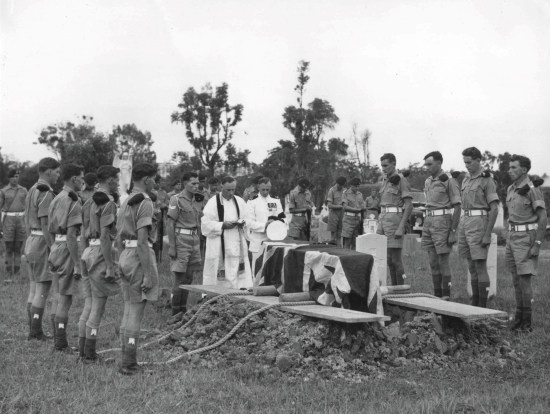
43 Commando RM
-Formed in August 1943 as 43 RM Commando from Marines from the disbanded 2nd RM Battalion, the Commando saw service as part of 2 Commando Brigade until the end of the war when it was disbanded.
43 Commando RM was re–formed on the 5th September 1961 at Stonehouse Barracks Plymouth under the command of Lieut. Col. Willasey-Wilsey MBE,MC,RM. [1] and remained operational until disbanded again at Eastney on the 1st October 1968 [2].
43 Commando RM was more recently reformed as 43 Commando Fleet Protection Group Royal Marines. It is the largest in the Corps and is responsible for protecting the nation’s nuclear deterrent as well as taking the fight to modern-day pirates in specialist boarding teams.
Historical note Associated units - Comacchio Company Royal Marines (1980–1983), Comacchio Group Royal Marines (1983–2001) and Fleet Protection Group Royal Marines (2001-2012) Sources [1] RMRO 154 dated 1961 [2] RMRO 192 dated 1968'Comacchio Company RM'
Comacchio Company Royal Marines existed between 1980 and 1983 and was responsible for protecting the nation’s nuclear deterrent. It was later redesignated Comacchio Group Royal Marines (1983–2001) and then Fleet Protection Group Royal Marines in 2001. In 2012 it was formally redesignated again as 43 Commando RM.
'Comacchio Group RM'
Comacchio Group RM was responsible from 1983 for protecting the nation’s nuclear deterrent. It's predecessor was Comacchio Company Royal Marines. In 2001 it was redesignated Fleet Protection Group Royal Marines which in turn became 43 Commando RM in 2012.
'Fleet Protection Group RM'
Fleet Protection Group Royal Marines exsited between 2001 to 2012 and was responsible for protecting the nation’s nuclear deterrent. Prior to that it was known as Comacchio Company (1980-83) and Comacchio Group (1983 - 2001). In 2012 it was formally redesignated as 43 Commando RM, the largest in the Core, and has the combined role of protecting the nation’s nuclear deterrent as well as taking the fight to modern-day pirates in specialist boarding teams.
'45 Commando RM'
Formed as 45 RM Commando in August 1943 from the disbanded 5th RM Battalion. World War 2 operations included the Normandy landings and the crossings of the rivers Rhine, Weser, Aller and Elbe. Redesignated 45 Commando RM in March 1946.
Read the WW2 history of the unit here [45RM Commando history].
The Commando was one of the three RM Commando Units not disbanded after the war. On 31 january 1946, at Chatham, 45 embarked on board the aircraft carrier HMS Rajah for the Far East arriving at Port Said on 11 February and Singapore on 1 March. They arrived at Kowloon on 7 March.*
It was redesignated as 45 Commando Royal Marines in March 1946.
The post-war years saw the Commando deployed on operations to Palestine, Suez, Malaya, Aden and Cyprus. The Commando finally returned to the UK in 1967 after 24 years operational service abroad and moved to its current base in Arbroath in 1971.
Since then they have been deployed in Northern Ireland, and, in 1982, the Commando took part in Operation Corporate, the recapture of the Falkland Islands. In 1991 the Commando deployed to Northern Iraq on a humanitarian assistance mission and in 1994 it was dispatched to reinforce the Kuwaiti border against renewed Iraqi aggression. More recently the Commando has been deployed on operations in Afghanistan.
* The book 45 - The Story of 45 Commando Royal Marines 1943-1971, author David Young
'29 Commando Regiment RA'
The first Army Commandos were raised by a Gunner, Lt Col John Durnford-Slater RA in June 1940, following the defeat ending with the evacuation at Dunkirk, The Commandos struck at the German forces at a time when Britain was otherwise powerless. Raids were made on the coasts of Norway, France and the Mediterranean. By the time of the Normandy landings of 6 June 1944, the Commando forces were of a considerable size and had played a vital part on operations in all theatres of war.
After the Second World War the Commando role passed entirely to the Royal Marines, the Royal Navy’s amphibious infantry. Army Commando units ceased to exist. In the late 1950s, Britain’s defence policy began to stress the importance of a worldwide maritime strategy. The Royal Navy commissioned Commando Carriers such as HMS Bulwark and HMS Albion. The Royal Marines, who no longer had their own artillery decide that they required support from an Army artillery Regiment.
During 1962, 29 Field Regiment RA were deployed with 25 Pounder guns in Aden and Kuwait, deterring Iraq from invading the oil fields. On the back of these deployments, the Regiment was chosen to re-role as Commando Artillery. The men of the newly formed 29 Commando Regiment RA trained for and passed the All Arms Commando Course at Commando Training Centre Royal Marines Lympstone. It was a proud and historic moment when the first Army Commandos since the end of the War received their Green Berets on 15 May 1962. The 25 Pounders in service with the Regiment at that time were then replaced by the 105mm Pack Howitzer. In 1965, 95 Commando (Light) Regiment, Royal Artillery, was formed. In 1971 95 Commando joined with 29 Commando.
Since this time, 29 Commando Regiment Royal Artillery has deployed around the globe as part of 3 Commando Brigade. Over the last 43 years the Regiment has operated in every major conflict the Brigade has been involved in. This has included Brunei (1962), Borneo (1963-66), Aden (1966-67), Cyprus (1974), The Falklands (1982) and numerous tours of Northern Ireland. More recently the Regiment has deployed to Iraq (1991 and 2003), Kosovo (1994), Bosnia (1996), Sierra Leone (2000), and Afghanistan (2001, 2006, 2008 and 2011).
The composition of the Regiment since it’s formation in 1962 has changed constantly to accommodate the demands made on the UK Armed Forces.
To become a Commando Gunner you must pass the arduous All Arms Commando Course held at Royal Marines Training Centre, Lympstone, which in turn earns you the right to proudly wear the coveted Green Beret.
[Source MOD]
Gallery Images of 95 Commando and 29 Commando
95 Commando (Light) Regt. RA
7 (Sphinx) Battery
Commando trained currently based at RM Condor, Arbroath.
8 (Alma) Battery
Commando trained. Currently based in the Royal Citadel Plymouth the Battery is known as "Black Eight" because of their efforts at the Battle of Alma where the Battery fired more rounds than any other leaving the faces of the gunners black with powder stains. Black Eight is the second gun battery in 29 Cdo. Regiment and is also equipped with six 105mm Light Guns and three Observation Parties.
145 (Maiwand) Commando Battery
29 Field Regt RA became 29 Commando Lt Regt, RA in 1962. This consisted of 3 gun batteries - 8 (Alma), 79 (Kirkee) & 145 (Maiwand). Each battery consisted of 4 x 105mm Pack Howitzers (Italian Mountain Gun) and manned by approx. 65 men.
23 (Gibralter 1779 -1783) Battery
Commando trained HQ Battery based at the Royal Citadel, Plymouth including RLC attached ranks.
79 (Kirkee) Battery
The Battery converted to the Commando role on 15th May 1962. Two years later saw the Regiment based in Singapore and serving in Borneo and Malaya where it saw action in the jungle role. The early seventies saw the battery based in Malta until it returned to The Royal Citadel in 1974. The troubles in Northern Ireland saw the Battery deployed on four Operation BANNER tours. The Battery has also served as part of the UN peacekeeping force in Cyprus on two occasions, the last in 1995.
In 1982 the Battery deployed with the Regiment on Operation Corporate, the operation to recover the Falkland Islands. Landing in San Carlos on 21 May 1982 the Battery was the first fire unit ashore and the first to fire in anger. Over the course of the war the Battery fired 2,200 rounds and the tactical group supported 42 Commando on foot throughout. Initially moving to Teal Inlet on 31 May the battery moved to Estancia House alongside 3 PARA and finally to Two Sisters within range of Port Stanley. The campaign was the ultimate test for Regiment in extremely hostile conditions which tested gunnery, men and logistics to their very limits and then further still.
The Battery took part in Operation Haven in1991 to provide a safe and secure haven for the Kurds against Saddem Hussein in Northern Iraq and three years later in 1994 it reinforeced 7 Battery with two Fire support Teams and two gun detachments for Operation Driver to block predicted Iraqi incursion into Kuwait which had echoes of the deployment to Kuwait of 1961.
Kirkee served in the Balkans in 1995 as part of Operation Lodestar (Bosnia-Herzgovina). In 2003 the Battery was split up to reinforce 7 and 8 Batteries for Operation Telic 1, the liberation of Iraq. In 2005 the Battery deployed to Helmand Province Afghanistan on Operation Herrick V returning two years later on Operation Herrick IX. The Battery’s latest operational deployment was to Afghanistan in 2011 on Operation Herrick XIV. The Battery also contributed, at short notice, to the security for the hugely successful 2012 Olympic Games in London.
Source: The Royal Artillery Association .
148 ( Meiktila ) Battery
History
(source Stu Hart (ex 29 Cdo) : The Combined Operations Bombardment Units (COBUs) provided fire direction for ships in shore bombardment in World War 2. The first COBU was formed in 1940 and by the end of the war there were five in existence. In 1946 all were disbanded, except No.2 COBU which joined the School of Combined Operations (later the Amphibious Warfare Centre) at Fremington. 3 Independent Combined Operations Bombardment Troop (3 ICOBT) was raised to serve with the 40th Infantry Division in Hong Kong in 1949 and soon more Amphibious Observation Units, as they were now called, were in existence. These were combined to form 95th Amphibious Observation Regiment, with its headquarters at Fremington in Devon but batteries stationed at fleet bases throughout the world. 166 Battery, based at Malta, participated in the Suez invasion in November 1956(Operation Musketeer).
148 Battery has been in existence under various names since 1842. After 1945 it became a training unit but converted to the Amphibious Observation role in 1960. At around the same time it was decided that the Royal Marines, who no longer included gunners in their ranks, needed specialist fire support from an Army artillery regiment. Up until then 3 Commando Brigade had relied on whatever gunner regiment was available. 29th Field Regiment was serving in Kuwait in 1962 when it was chosen to take up this role. Its members were to be the first Army Commandos since 1946 and the first men to complete training received their green berets on 15 May 1962. Later 95 Regiment was also re-roled as a Commando Light Regiment with the 105mm pack howitzer. 148 Battery was to continue in the amphibious observation role for 95 as a Commando Forward Observation Battery, while 20 Battery did the same job for 29. Later a Territorial Army unit, 881 Battery, was formed.
Members of 148 Battery saw service in the Malay Peninsula 1963-66, Borneo 1963-66, the Radfan in 1964 and in Aden at various times between 1960 and 1967. In 1971 the battery returned to the UK from Singapore, along with the rest of 3 Commando Brigade, and took up its present location at Poole. With the general reduction of the Royal Navy and gun-armed ships in particular there seemed to be less need for such units. The various batteries had at certain times changed regiments so when 95 Commando Regiment was disbanded in 1975, 148 Battery survived as part of 29 Regiment. 20 and 881 Batteries were not so lucky and 148 became the sole remaining NGFO unit. It too was scheduled for disbandment when Argentina invaded the Falkland Islands in April 1982.
289 Commando Light Battery (V)
A volunteer military reservist unit of Greater London. Redesignated in 1977 as 289 Commando Light Battery (V) from 289 Parachute Battery RHA (V).
24 Commando Royal Engineers
Current ORBAT
24 Commando Royal Engineers
56 Commando Headquarters and Support Squadron
54 Commando Squadron
59 Commando Squadron
131 Commando Squadron
REME Workshop.
131 Commando Squadron is the Army Reserve sub-unit of 24 Commando Royal Engineers. 131 has served in over 60 nations and territories worldwide. Since 1978 it has supported the Royal Marines and Commando Forces. Before that it was a parachute unit, supporting the Parachute Regiment.
[Source: MOD].
View the Gallery images of Army Commando Sappers
59 Independent Commando Sqn. RE
“The Brigade Commander, Brigadier Peter Whitely asked me what we should call the newly announced Commando Squadron.
I replied 59 Independent Commando Squadron Royal Engineers to harmonize with 9 Independent Parachute Squadron Royal Engineers who are a unit of 16th Parachute Brigade.
He was delighted with the suggestion and that he now had his own dedicated Royal Engineer Squadron in the Brigade”.
Commando Troop EOD, RE
1 and 2 Troops of 49 EOD Sqn. were detached into a separate Explosive Ordnance Clearance (EOC) group, directly under 33 Engineer Regiment and two new Troops formed within 49 EOD Squadron: 1 (Para) Troop and 2 (Commando) Troop.
Currently the Commando Troop of 821 Explosive Ordnance Disposal Squadron, RE, consists of four EOD and Search teams aligned to the Lead Commando Group.
Source
'Commando Logistic Regiment RM'
Based at Chivenor in North Devon, the Regiment is home to about 780 personnel from all three services, including Royal Marines, Mechanical Engineers, Medics and Logisticians. The Regiment is unique in Defence in that no other unit has such an eclectic mix of cap badges working together towards providing Equipment, Medical and Logistical support.
Commando Ordnance Field Park 1964 – 1972. Formed 1964 as Support to 3 Commando Brigade. Service included Singapore 1964 & Borneo 1965.
Commando Ordnance Squadron 1972 – 1996. Service included Brigade Support during Op CORPORATE Falklands Campaign and many other deployments.
Commando Logistic Support Squadron 1996 to present day. Service included Op HAVEN, Op AGRICOLA, Op JACANA, Op TELIC & Op HERRICK 5, 8 & 14 and many other deployments.
'Cdo. Logistic Regt. RM formation'
- 3 Commando Medical Section (Singapore) and 4 Commando Medical Section (Plymouth) combined to form the Commando Medical Squadron.
- 3 Commando Transport and Composite Platoon (Singapore) and 4 Commando Transport and Composite Platoon (Plymouth) combined to form the Commando Transport Squadron.
- 3 Commando Brigade OFP (Singapore) formed the Commando Ordnance Squadron.
- 3 Commando Workshop (Singapore) and 4 Commando LAD (Malta) formed the Commando Workshop Squadron .
- Elements of Camp HQ Plymouth Group formed the Garrison Squadron.
- 1st Raiding Squadron (Singapore) and 4th Raiding Squadron (Plymouth) combined to form the Raiding Squadron (1RSRM).
On January 11, 1972 the Commando Logistic Regiment held its inaugural parade at Stonehouse Barracks, Plymouth.
The address was given by the Commandant General Royal Marines Lt Gen B. I. S. Gourlay, OBE, MC and included the following remarks: 'Today you find yourselves members of a very special and new team, a partnership of many skills brought together under a single hand and devoted to a single aim, namely, that of supporting the Commandos, and this in a more co-ordinated and efficient way than has been possible to date'. He continued, 'You can count amongst you, in addition to the Royal Marines and Royal Navy cap badges and tallies, the insignia of three famous Corps of the British Army. I believe that this bringing together of varied skills, different points of view, and distinctive jargon lends strength to the Regiment as a whole, and gives it a fine flavour of its own'.
During 1972 two assault detachments were sent from the Ordnance Squadron on a permanent basis, to 45 Cdo Gp in Arbroath (No 3 AOD) and 41 Cdo Gp in Malta (No 1 AOD). No 3 and No 1 Advanced Workshop Detachments were similarly deployed and finally in 1976 No 3 Medical Troop was formed and detached to 45 Cdo Gp for second line support in its M & AW role.
In addition, in 1972, a combat supplies troop was formed from the Commando Ordnance Squadron to work with the Commando Transport Squadron and the expertise of this Troop led to the formation of a local Resources Team in 1976. It can be seen therefore, that the young Commando Logistic Regiment which is to parade before Her Majesty on August 5 has roots that extend well back into the past 25 years.
47 Commando (Raiding Group) RM
539 Raiding Squadron RM
539 Assault Squadron was renamed 539 Raiding Squadron Royal Marines in November 2019. This Unit is a vital link in the Corps' chain, allowing 3 Commando Brigade to transfer onto land from the sea or river. It can operate amphibious Viking vehicles to deliver force into territories.
The unit served with distinction in Iraq's Al Faw peninsula during operations in the last decade, but it has also operated around the world with the Royal Navy's amphibious ships HMS Albion and HMS Bulwark and the helicopter carrier HMS Ocean.
Throughout the summer of 2012 the unit contributed to the Royal Navy’s role in Olympic security. It was one of the Commando units taking part in the Cougar 2012 amphibious deployment to the Mediterranean.
[Source: Royal Navy/MOD]
'30 Commando IX Group'
'Commando Helicopter Force'
The three squadrons of the Commando Helicopter Force are the wings of the Royal Marines, providing crucial aerial support to the green berets be they at sea in an assault ship or in the sand and dust of Afghanistan.
Known as ‘The Junglies’ for their operations in Borneo during the 1960s, then designated as Air Troops of 3 Commando Brigade RM, Commando Helicopter Force consists of three Naval Air Squadrons – 845, 846 and 847. Together, they use Merlin and Wildcat helicopters to provide air support to 3 Commando Brigade Royal Marines and other UK forces.
From battlefield reconnaissance and joint fire support to training Aircrew and Engineers for the front line, Commando Helicopter Force’s role is perhaps best summed up by the motto of 847 Naval Air Squadron: ‘We Strike From On High’.
3 Commando Bde. Air Squadron
'Commando Mobile Air Operations Team'
The Commando Mobile Air Operations Team (MAOT) is an elite Royal Navy unit that provides specialized assistance to the Commando Helicopter Force (CHF). All members of the unit are commando trained.
845 Naval Air Squadron
Provides airborne support for the Royal Marines of 3 Commando Brigade.
846 Naval Air Squadron
Provides airborne support for the Royal Marines of 3 Commando Brigade.
847 Naval Air Squadron
Transcript of Royal Marines Routine Orders 105/95
Re-designation of 3 Cdo Bde Air Sqn RM as 847 Naval Air Squadron (R)
1. 3 Commando Brigade Air Squadron Royal Marines will be formally incorporated into the Naval Air Command on Friday 1 Sep 95 and be re-designated 847 Naval Air Squadron.
2. The Squadron will continue to operate Army Lynx and Gazelle aircraft until the introduction of the Attack Helicopter into Army Air Corps Service.
Thereafter it will continue in the light utility role in support of 3 Commando Brigade Royal Marines.
'Royal Marines Reserve'
- RMR Scotland draws recruits from across Scotland, North East England and Northern Ireland.
- RMR Bristol draws recruits from across South West England and Wales.
- RMR London draws recruits from across the south east of England.
- RMR Merseyside is based in central Liverpool and draws recruits from the North West, North Wales, the Midlands, Yorkshire and the Humber.
'Royal Marine Forces Volunteer Reserve'
R.M.F.V.R. Sea Service Wing [3].
" I joined the R.M.F.V.R. (Commando Wing) two years ago and its just like old times. Our O.C. is also an ex Army Commando," writes Cpl. (now Sgt.) A. Munro (9 Cdo), H.M.S. Claverhouse, Leith, Edinburgh.
"...was one of the first to volunteer for RMFVR, City of London, in the Sea Service Wing."
'R.M.F.V.R. - formation’
My Lords, the Bill of which I am asking your Lordships for the Second Reading this afternoon is, I think, uncontroversial. The Bill has two objects designed to one main purpose, and that is to increase the reserves available to the Royal Marines on mobilization. Although the numbers involved in this Bill are small, I am sure that your Lordships will all recognize that it deals with a very fine body of men.
The Corps of Royal Marines was first raised from trained bands of the City of London about 300 years ago. From the outset it was constantly in use for naval purposes, and the first major engagement on land took place in the capture of Gibraltar in 1704. This was the beginning of a long record of gallant service and proud tradition, culminating in the actions of the Second World War in Crete, France, Holland and elsewhere. Many of our famous Service leaders have spoken in the highest terms of the value of the Marines to the country. Admiral Lord St. Vincent actually used the words: If ever the hour of real danger should come to England they will be found the country's sheet anchor.
Times change and this can no longer be said of what, for all the glory of their past, is now a comparatively small body of men. Nevertheless, for its size the Corps is now no less a vital component of our Armed Forces than it has been in earlier times, a fact brought about no more by the increased functions lately assigned to them than by the conspicuous gallantry which they have displayed in all those actions in which they have taken part.
As I have said, the purpose of this Bill is to increase the reserves available to the Marines on mobilization. The present system of reserves relies only on pensioners who are over forty years of age and on voluntary entrants into the Royal Fleet Reserve, and we consider that these will no longer be sufficient to meet requirements. The reason is that the functions of the Marines have increased considerably. Before the Second World War their main function was to provide detachments on board ship—and only on large ships—to man parts of the armament and to be used on operations on shore under the Naval Commander-in-Chief.
Their functions have now been extended, principally in the all-important field of combined operations. They have now to undertake the manning of assault craft and the provision of commando and special amphibious assault units. In addition, they have duties in connexion with beach communications, beach control and naval bombardment. It is for these purposes that we need an increase in the number of Royal Marines.
The Bill therefore provides, as a first object, for the creation of a Royal Marine Forces Volunteer Reserve, on the model of the Royal Naval Volunteer Reserve, the members of which will, when called up, serve as Marines. This means that their terms of pay and conditions of service will be those of the Marines, and that their disciplinary code will rest on the Naval Discipline Act or the Army Act, according to whether they serve afloat or ashore.
The second object of the Bill is to provide for the enlistment of Royal Marines for Special Service; that is, to serve part of their twelve years on active service and the rest in the Royal Fleet Reserve. The actual periods of service are left indefinite in the Bill, for they will be determined by regulation, as in the case of the Royal Navy. For the Royal Navy the periods of active service and service in the Reserve are normally seven years and five years respectively, and it is contemplated that the arrangements for the Royal Marines will be similar. Provision is made for a Royal Marine so enlisted to be transferred to a long-service engagement by mutual consent, thus bringing the engagement systems of the Royal Navy and the Royal Marines into line.
Your Lordships will see that Clause 1 of the Bill is devoted entirely to the first object, and, similarly, Clause 2 to the second. Clause 1 (1) makes it lawful to raise a Volunteer Reserve for the Royal Marines. The number is not limited by law, but for a start we aim at a figure of about 1,500. I cannot say what the ultimate figure will be, but 1,500 is the immediate aim. Subsection (2) places the Reserve in the same legal position as the Royal Naval Volunteer Reserve, with the proviso that when mobilized its members serve as Marines and not as seamen. This has been done by applying the Statutes which govern the Royal Naval Volunteer Reserve. Subsections (3) and (4) add the Royal Marine Forces Volunteer Reserve to the list of Naval Reserves in the various Acts and Statutes where they are already mentioned. Subsection (6) repeals the long obsolete Section 2 of the Naval Forces Act, 1903.
Clause 2 (1) allows Marines to be entered for Special Service on the lines I have indicated. Subsection (2) is technical. The Royal Marines Act says that at a certain point in his service a man may do certain things. For example, he may re-engage for service or he may have certain things done to him; he may be brought home from abroad. This subsection provides that for a Special Service Marine the date to which those things are related will be the end of the active service part of his engagement, rather than after his completed service which, legally, includes his period with the Reserve. It is made clear that a Royal Marine may transfer from Special to Continuous Service. There is a similar provision in the Royal Navy.
In conclusion, may I repeat that the Force for which we now desire to form a Voluntary Reserve, and to provide for Special Service enlistment, has a splendid tradition of action and gallantry. There can, I think, be no possible doubt but that the men required will come forward, and that in emergency they will follow honourably and with distinction in the 1038 footsteps of those who have made the title "The Royals" what it means to the world to-day. I feel sure that your Lordships will welcome this Bill and it is therefore with confidence that I ask for a Second Reading. I beg to move.
RMFVR History
Prior to the establishment of the RMFVR, time served Marines could volunteer for the Royal Fleet Reserve, most had served at least 12 years in the regular Corps, with many having completed a full 21 years to pension. The Royal Fleet Reserve was created under the ‘The Naval Reserve Act, 1900,’ and of ‘The Naval Forces Act, 1903,’ to provide a reserve of trained men for service in His Majesty’s Fleet in time of emergency. Sailors and Marines who had completed more than five years regular service were eligible to join and those who in receipt of a pension received an extra five pennies a day. The men attended a week’s annual drill at their home division. The August 1914 G&L reported: ‘SPITHEAD, and the Fleet, and the King (our Colonel), and airships, and aeroplanes, and hydroplanes-the air is full of them. Something to be proud of-all this. But we have had a little bit of luck all our own – barracks crowded and running over into tents with Fleet Reserves; parades with the old hands, recruits, and Cadet Corps – the past, the present, and the future. We have seen battalion drill excellently performed by men usually employed in doing every other job under the sun, and old instructors from every type of civilian employment just talking to and teaching their squads and sections in the same old way, just as though they had never left. Anyhow, we’ve felt it something to be proud about. We hear a lot of being fed up with the North Sea, and going at twelve years, but does that matter a hang for England if the old hands come back when they are wanted? Going at twelve years makes room for recruits all the more trained for England’s needs, and we have seen that the training is never wasted – just there when England wants it. Something, too, of esprit de corps in all this – something that shows it is not just an empty bit of French, but a real bit of ‘jolly’ English.’ About 2am, on 2 August 1914 the order to mobilise reserves and pensioners was issued to the Grand Divisions, and men were coming into Barracks by 8am, and practically by next day all were in – many Marines and pensioned SNCOs returned to the Colours, the units of the newly formed RND had large pensioner NCO cadres. The first casualty at Gallipoli was an RFR recalled pensioner – CSgt Alf Baldwin had retired in 1910 after 22 years’ service, he joined the RFR and was recalled in 1914. Serving with the Plymouth Btn at Gallipoli he was one of the first ashore at Sedd-ul-Bahr on 4 March 1915 – there was no opposition to our landing at Sedd-ul-Bahr, except some long-range artillery fire, until the leading men of the patrol started to debouch from the path at the head of the camber into the road which ran between the fort and village. They were immediately met by rifle fire and had to take cover behind a drinking fountain in the middle of the road. The remainder closed up under cover of a low stone wall behind it. It was here that CSgt Baldwin was killed in trying to pick off some snipers who were in the houses. After WW1 Marines continued to join the RFR for a period of five years, and continued to attend an annual training week and were available to be mobilised in time of war. Again in WW2 many of these reservists returned to the Colours on mobilisation in 1939, all were over 40 years of age, and as experience was to show, there was not enough of them, and most were needed for the Fleet and DEMS. After the War, the Parliamentary and Financial Secretary to the Admiralty, Mr John Dugdale, introduced the 1948 Act that formed the RMFVR to parliament – Hansard, ‘The purpose of this small and, I hope, uncontroversial Bill is to increase the reserves available to the Marines on mobilisation. It may be asked why we want to increase these reserves. The reason is that the functions of the Marines have increased. Before the last war the main function of the Marines was to provide detachments onboard ship, and only in large ships, to be used on operations on shore under the naval commander-in-chief. However, during the last war there developed what were known as Commandos and Combined Operations, and it is for this purpose that we need an increase in the number of Marines.
The Royal Marines Forces Volunteer Reserve was established in 1948 as a volunteer reserve force to provide a trained body of men to support the Royal Marines during times of war or national emergency. Originally organised in four centres as training wings inspired by the main wartime functions of the Corps, Sea Service, Amphibious, Commando and Small Scale Raiding wings. In 1966 their title was changed to Royal Marines Reserves and by then their principal training was concentrated on Commandos and Small Scale Raiding.
Lt Col RJ Freeman, RMFVR, Commanding Officer of the City of London Centre, reports the first 30 recruits for attestation, 5 November 1948 at Bunhill Fields.
In 2023 the Royal Marines Reserve will celebrate its 75th Anniversary. Discussion of a reserve for the Corps started much earlier, in fact as early as 1896. Whilst Marines could join the Royal Fleet Reserve from 1903 onwards, it is rightly to 1948 that the RMR traces its birth and the formation of the Royal Marines Forces Volunteer Reserve.
The Lord Mayor of the City of London reads the oath of attestation, on the same ground that the Royal Marines were formed in 1664.
RMFVR – City of London: Finsbury Barracks, City Road, EC2.
RMFVR Centre – City of Glasgow: Whitfield Road, Govan, Glasgow.
Recruiting at these Centres will begin on 1st November.
Arrangements are being made to open further Centres in Bristol and Liverpool during 1949. Subsequently other large towns in the country will receive consideration, including Belfast, Manchester, Birmingham, Leeds and Nottingham (or Leicester), though not necessarily in this order of priority.
In the City of Glasgow Centre it is proposed to open a Sub-Centre of the RMFVR at Greenock during 1949. In the case of certain other towns, it may also be necessary to form Sub·Centres in outlying districts. Each case will, however, be considered on its merits.
Each Centre will contain Units and Subunits which will cover the various commitments of the Corps in connection with Sea Service, Commandos, and Combined Operations. In this respect a Centre will not be the exact equivalent of a Territorial Army Unit or an Auxiliary Air Force Squadron, as it will cater for more than one commitment of the Corps.
The strength of each Unit or Subunit within a Centre will vary with the locality. The success of the new Reserve will depend very largely on the success of recruiting. To achieve this, local Commanders should make every endeavour to bring the facts concerning the Reserve to the notice of officers and other ranks who may know potential recruits in the areas of the London and Glasgow Centres.
Regulations concerning method of entry, pay and conditions of service will be promulgated shortly.
Co-operation with TA: Their Lordships have also approved that where necessary RMFVR Centres may be administered by the Territorial and Auxiliary Forces Association on behalf of the Admiralty. Such an arrangement is likely to be most beneficial to the Force both as regards accommodation and general facilities.
The City of London Centre will be so administered, whereas in Glasgow the Centre will be on similar lines to an RNVR. Division, but administered by CGRM.
Every endeavour will be made to acquaint those in the Bristol and Liverpool areas of the intention to open there in 1949.
By arrangement with the War Office, it will be possible for ex-Royal Marines and possibly some others to transfer to the Reserve if they at present belong to, or join later, the Territorial Army. No doubt similar arrangements could be made with the RNVR, in those places where an RMFVR Centre may be opened in the future.
It is realised that there will be some disappointment among those who find themselves too far away to join one of the few Centres that will be opened.
In large towns and areas Royal Marine Cadet Units will be raised. It is to be hoped that many who cannot join the RMFVR will interest themselves in this important youth movement.
The target of 1st November for opening the recruiting has been decided upon in order to avoid any further delay and consequent loss of interest due to other recruiting drives throughout the country. It is necessary to ensure that sufficient numbers are recruited before a new Reserve such as this begins training.
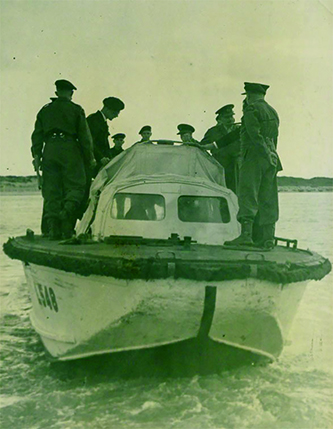
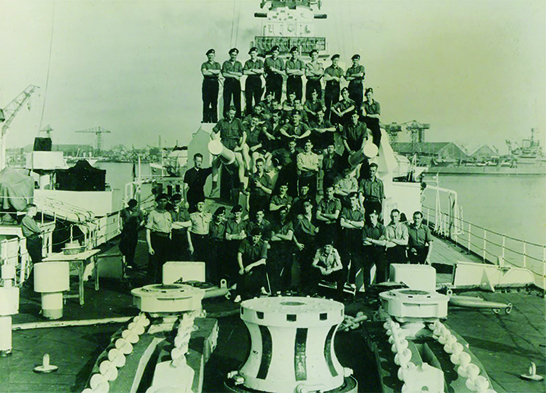
Direct Commissions. In order to provide new Centres with their establishment of officers a limited number of direct commissions will be granted to suitable applicants who have held wartime commissions in any of the fighting Services. Apart from this initial intake, it is intended that all officers of the RMFVR should be drawn from the ranks of the Force.
The exact period of training to be carried out by officers has not yet been finally decided. It is unlikely that any List I officer will be required to carry out more than an average of 14 days’ continuous training each year, which may be ashore or afloat.
Officers on List I are also required to attend for the equivalent of 80 hours’ drill per annum, which will normally mean attendance on 40 occasions for a period of two hours’ instruction. Weekend training will also be available and such periods will be deducted from those required by normal attendance at drills.’ List II officers may be required to carry out up to 28 days’ training annually until reaching the rank of Captain RMFVR when this commitment is reduced.
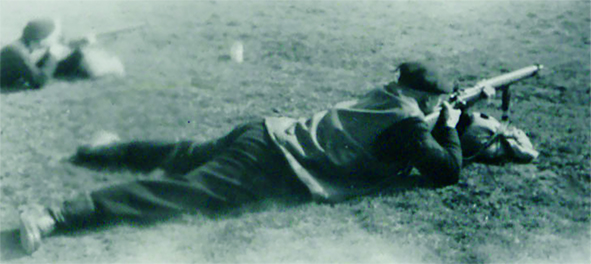
Applicants must be between the ages of, 18 and 45. Selected applicants, however, of the age of 17 may be accepted into the Force in special circumstances. So far as the overall establishment of the RMFVR will allow, every endeavour will be made to see that candidates with war service are granted the substantive rank held on release or discharge from the Service. It must be appreciated, however, that it will not be possible to do so in many cases or immediately on enlistment.’
On 5 November a ceremonial attestation for the first 30 recruits to the City of London was conducted by the Lord Mayor of the City of London at the Artillery Ground in Bunhill Fields. However the first thirty recruits attested at this ceremony were not in fact the first recruits in the RMFVR, Glasgow Centre add in all innocence of this ceremony had already attested some recruits. Recruitment for both centres flourished, recruits included retired Marines Navy, Army and RAF men and younger recruits who joined prior to undertaking National Service with the Corps.

Training for the two centres commenced in January 1949, divided for training purposes into Sea Service, Commando, Amphibious and Small Raiding Wings. Training took two evenings a week. Merseyside centre opened in February 1949 in Birkenhead and in March the Bristol centre opened.
The first annual training was held in June 1949 for the City of London and Glasgow centres, Merseyside and Bristol followed in November. Training was again divided according to wings. Sea Service wing went to the gunnery school Royal Marines at Eastney and onboard HMS Royalist; Amphibious Wings went to the technical training school Royal Marines also at Eastney as did the Small Raider Wings; the Commando wings went to the Small Arms School Royal Marines at Browndown. On 20 June Commandant General visited the training wings in their various locations.
In March 1951, the RMFVR centres were given the following unit and subunit responsibilities; 48(City of London) Commando RMFVR – City of London Centre:
47 Commando RMFVR
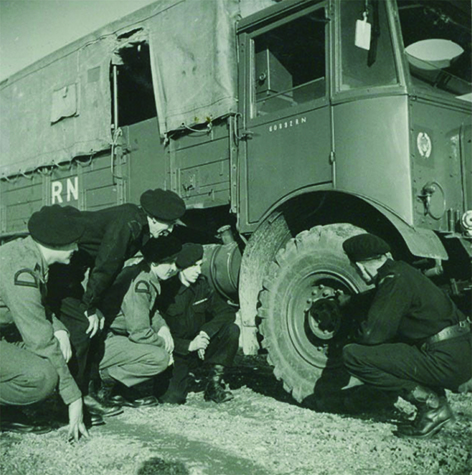
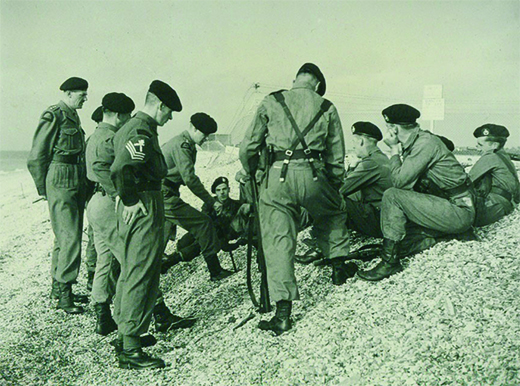

A Troop – Bristol Centre
B Troop – Merseyside Centre X Troop – Glasgow Centre
4th Special Boat Section RMFVR – City of London
5th Special Boat Section RMFVR – divided amongst other centres.
In November the same year a further allocation of responsibilities was set out; 2nd (City of London) Raiding Squadron RMFVR, consisting of:
Raiding Flotilla RMFVR
Assault Flotilla RMFVR
No2 Naval Beach Unit (Raiding) RMFVR 3rd Assault Squadron RMFVR
Assault Flotilla and No3 Beach Unit (Small) RMFVR – Glasgow
Assault Flotilla RMFVR and No4 Beach Unit (Small) RMFVR – Merseyside
Assault Flotilla RMFVR and No5 Beach Unit (Small) RMFVR – Bristol
In December 1951, the honour of wearing the Green Beret was conferred on those ranks of the RMFVR who had come up to certain qualifications during their normal drills and annual trainings. The following year’s annual training camp saw the first mass presentation… ‘On the last day of training and a week of summer weather teams from each of the provincial RMFVR Centres covered the course set by the School and already covered by City of London Centre for the 3 Commando Brigade Shield Competition. Glasgow won for the second time, under the leadership of Capt Walker. The shield was presented by the Commandant, Commando School RM on a ceremonial parade that afternoon. On the same occasion the Commandant presented the Green Beret to those who had earned it during the fortnight. Thirty ranks received their Green Beret from him.’
On 4 July 1956 the organisation of Commando wing was changed, 47 and 48 were disbanded and 46(VR) Commando was formed and in 1960 the Amphibious wing was wound up.
By 1962 RMR Merseyside was organised as; A Coy – initial training, B Coy – rifle coy of trained soldiers, The Rifle Troop – largest troop of the company containing the pool of trained soldiers and NCOS who were not LC, S or SBS rates, Landing Craft Troop, Signal Troop, The SBS and a HQ Company.
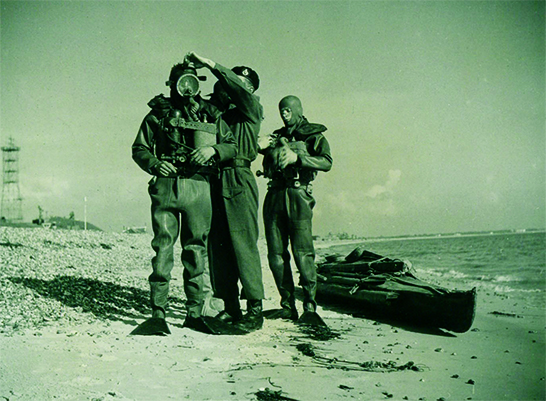
Later that year, 1962, 46(VR) Commando trained overseas for the first time, in Germany, and the Landing Craft and Sea Service wings were phased out. In 1963 Lt M F Lowe RMFVR served on operations with 42 Cdo in Borneo, the first reservist to serve on operations. By 1966 the attachment of reservists to serving units was well established. 1965 saw the first tactical/command course run for the RMFVR at Lympstone. On 1 October 1966 the name of the RMFVR was changed to RMR.
Sources:
Hansard.
The Globe & Laurel, 1896, 1947, 1948 and 1951.
A History of the Royal Marines Reserve 1948-1979. A History of the Royal Marines Reserve 1980-1990.
Photo album National Museum of the Royal Navy RMM2014/71 The Foundation of the RMFVR.
This excellent article was written by John Rawlinson of the RM Historical Society and published in the Globe and Laurel Magazine 30 June 2023. Re-produced with both their permission. PR.(Admin)
